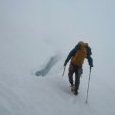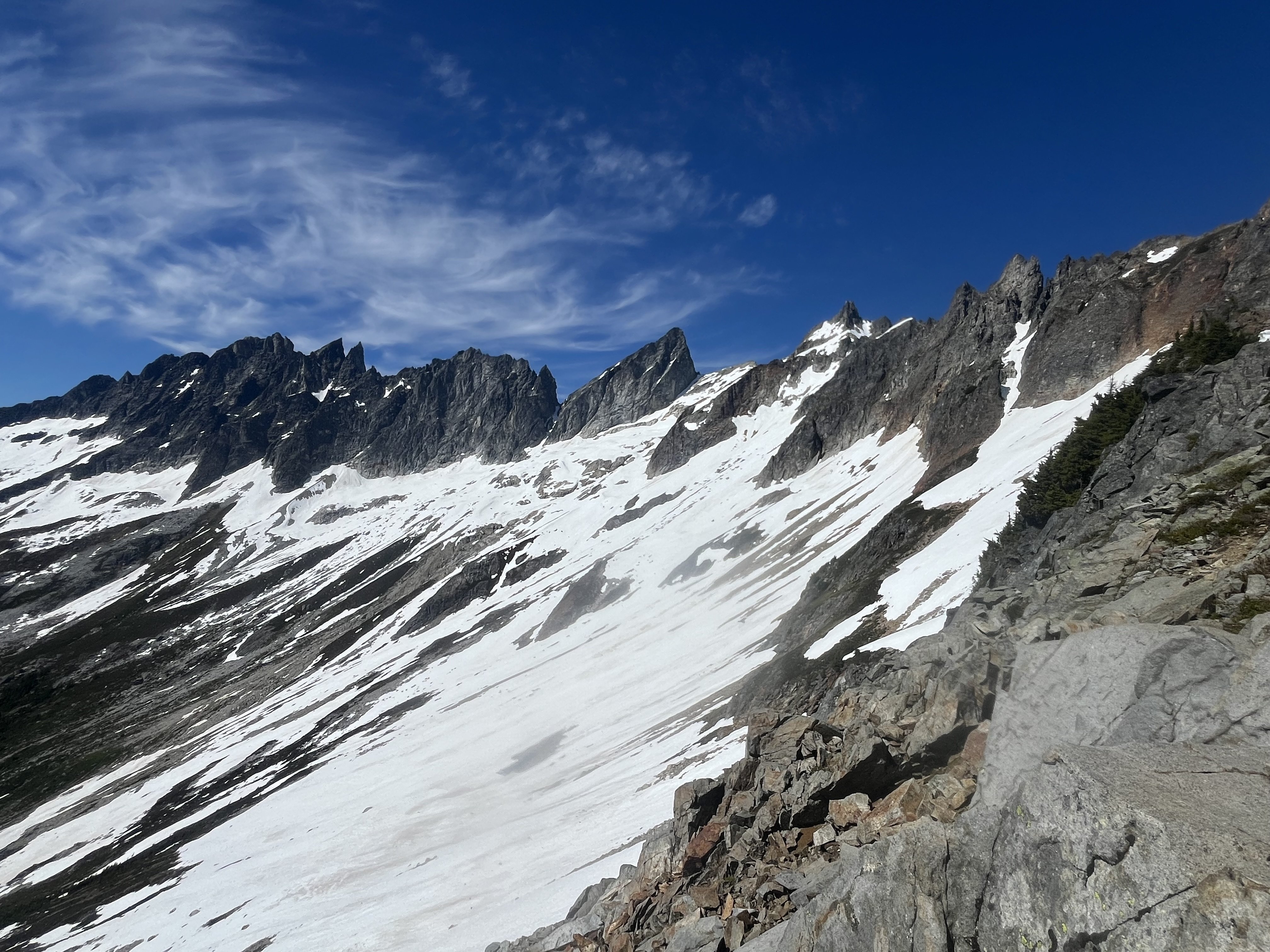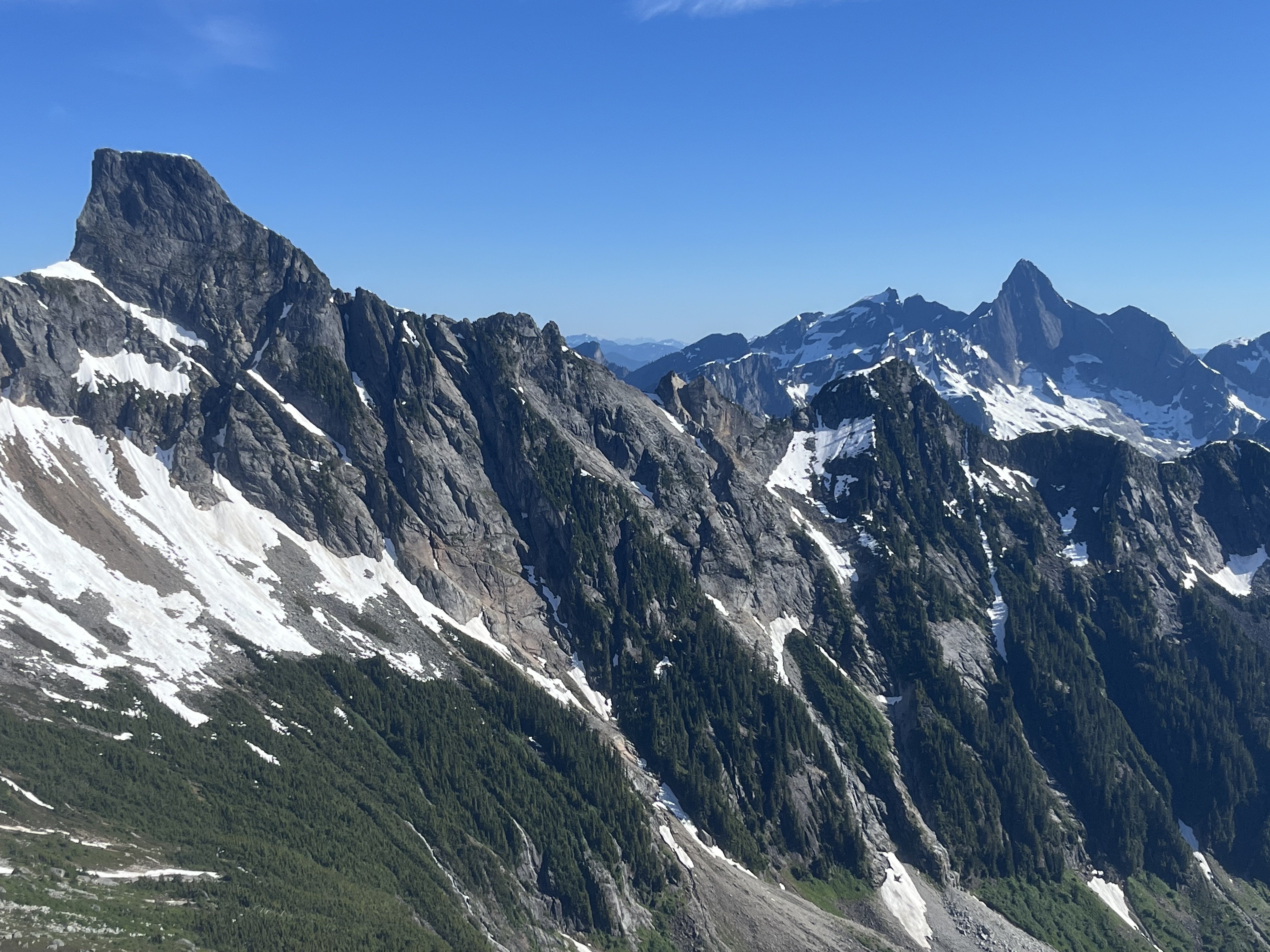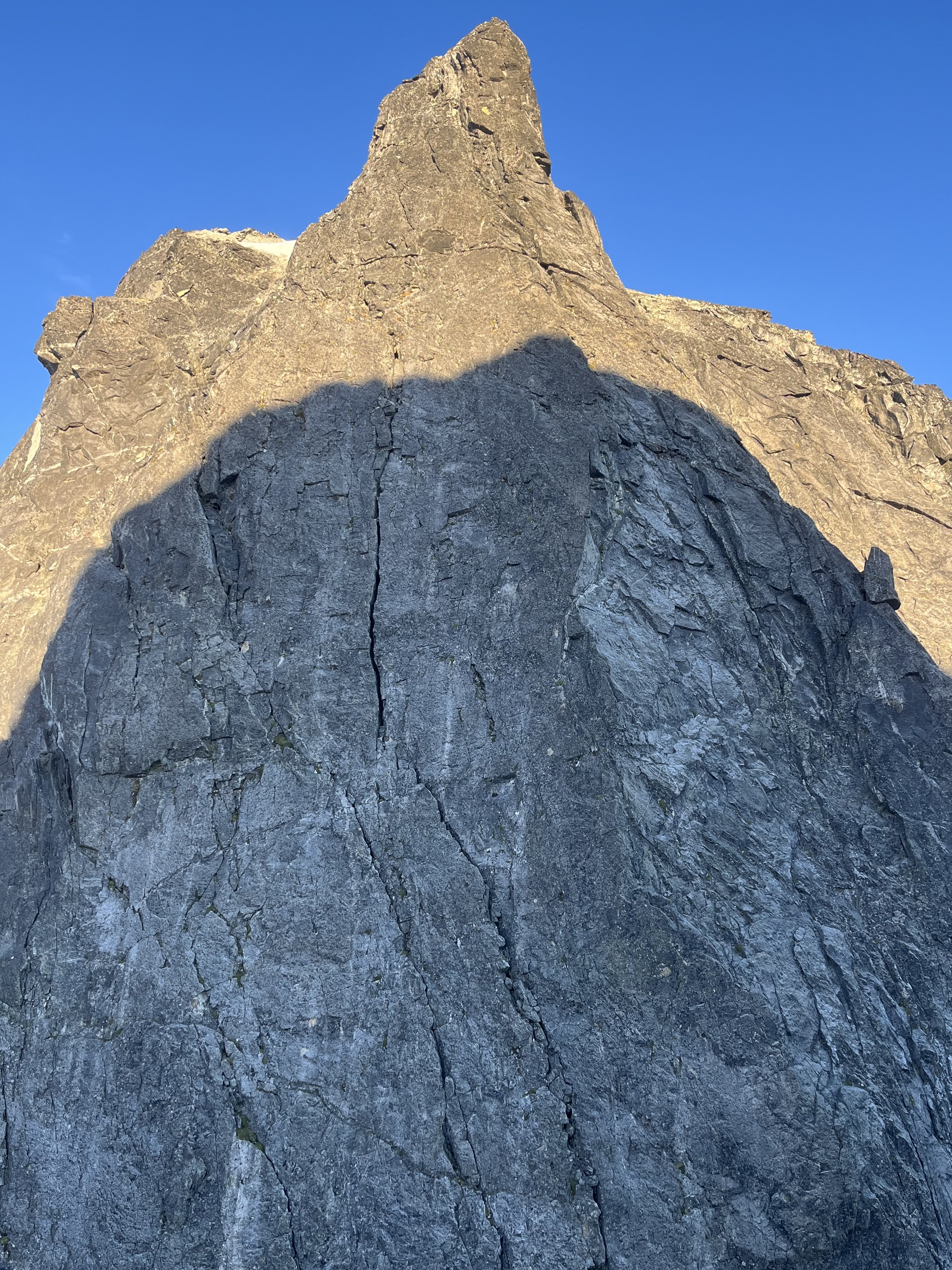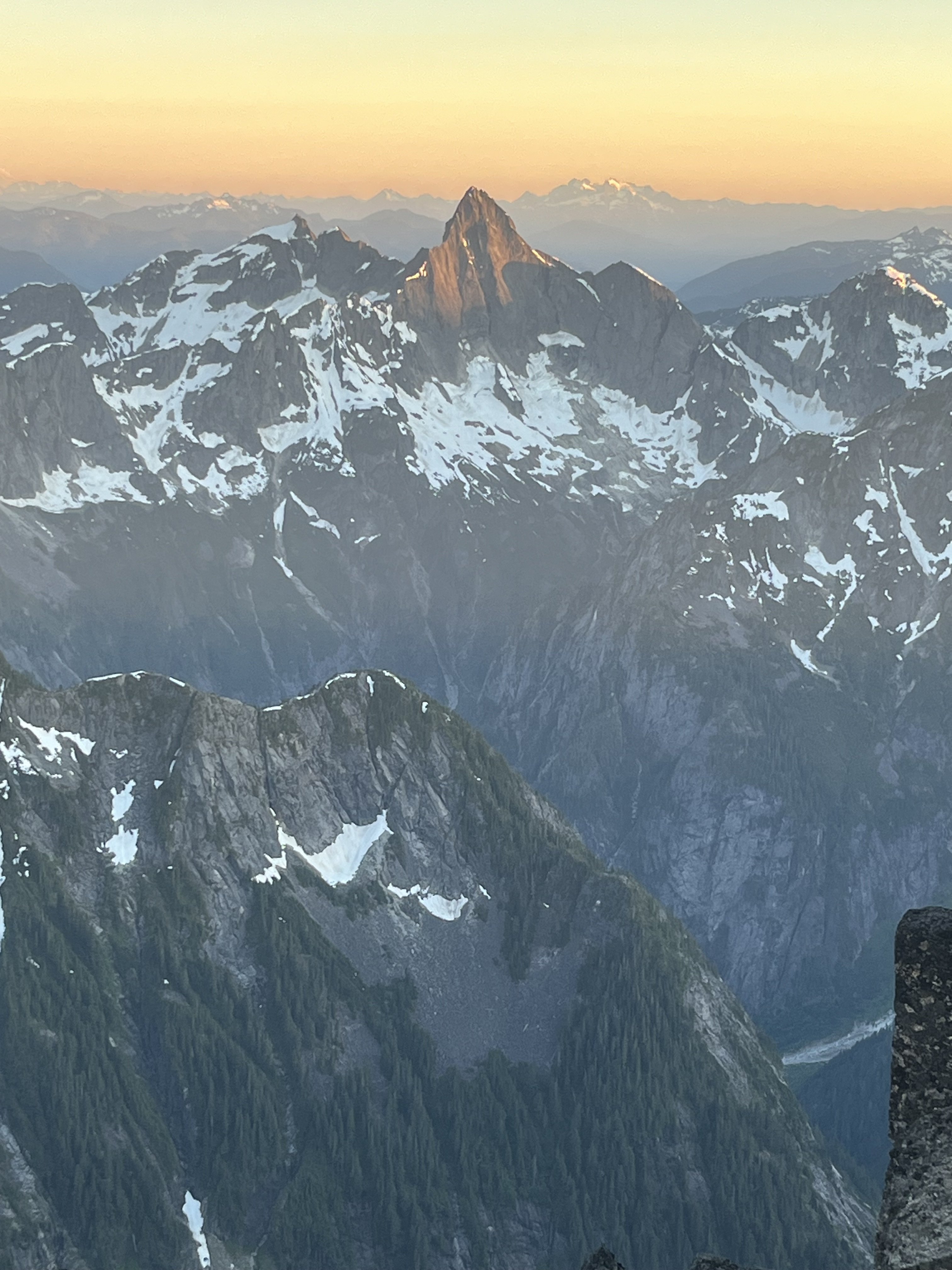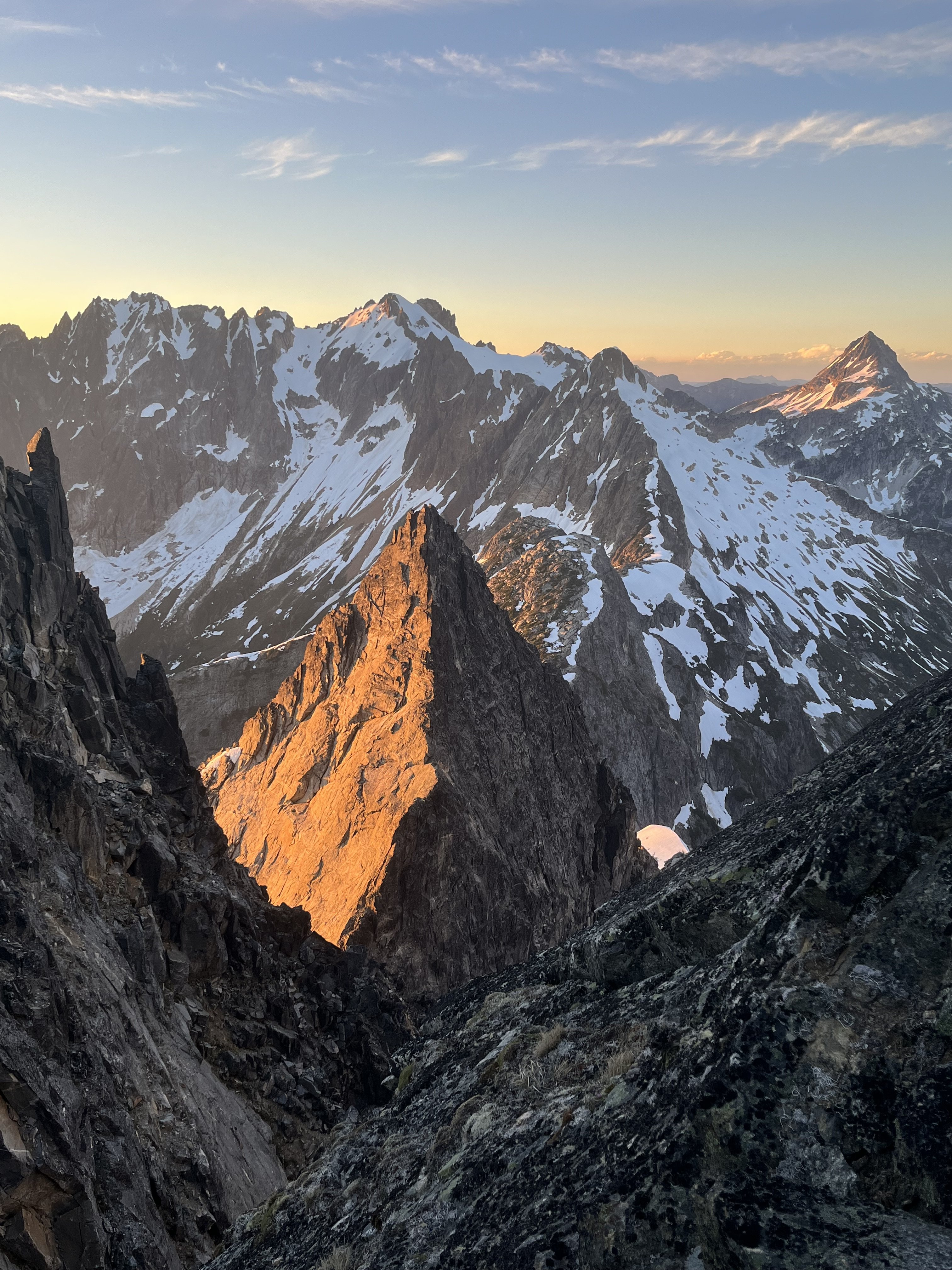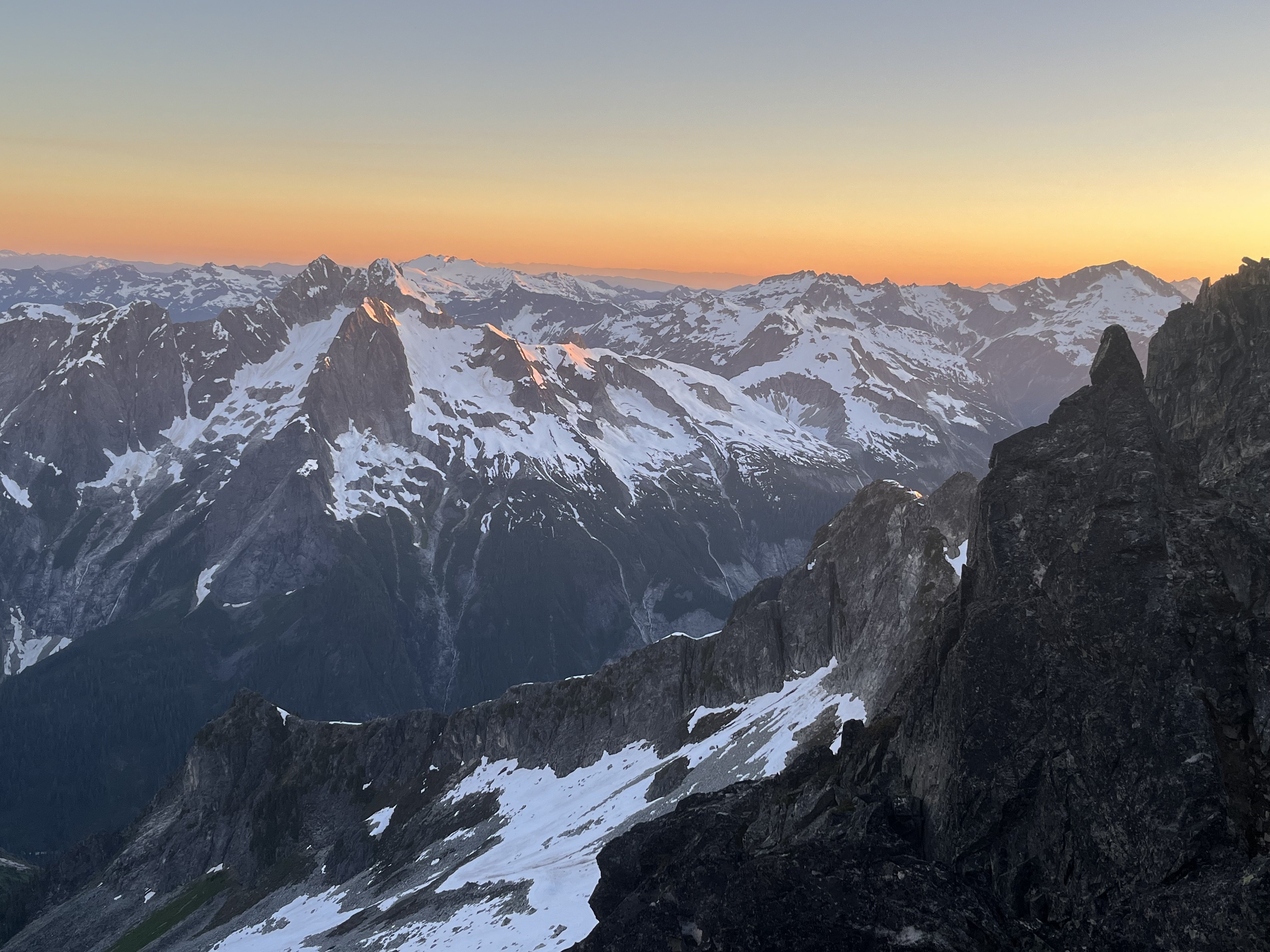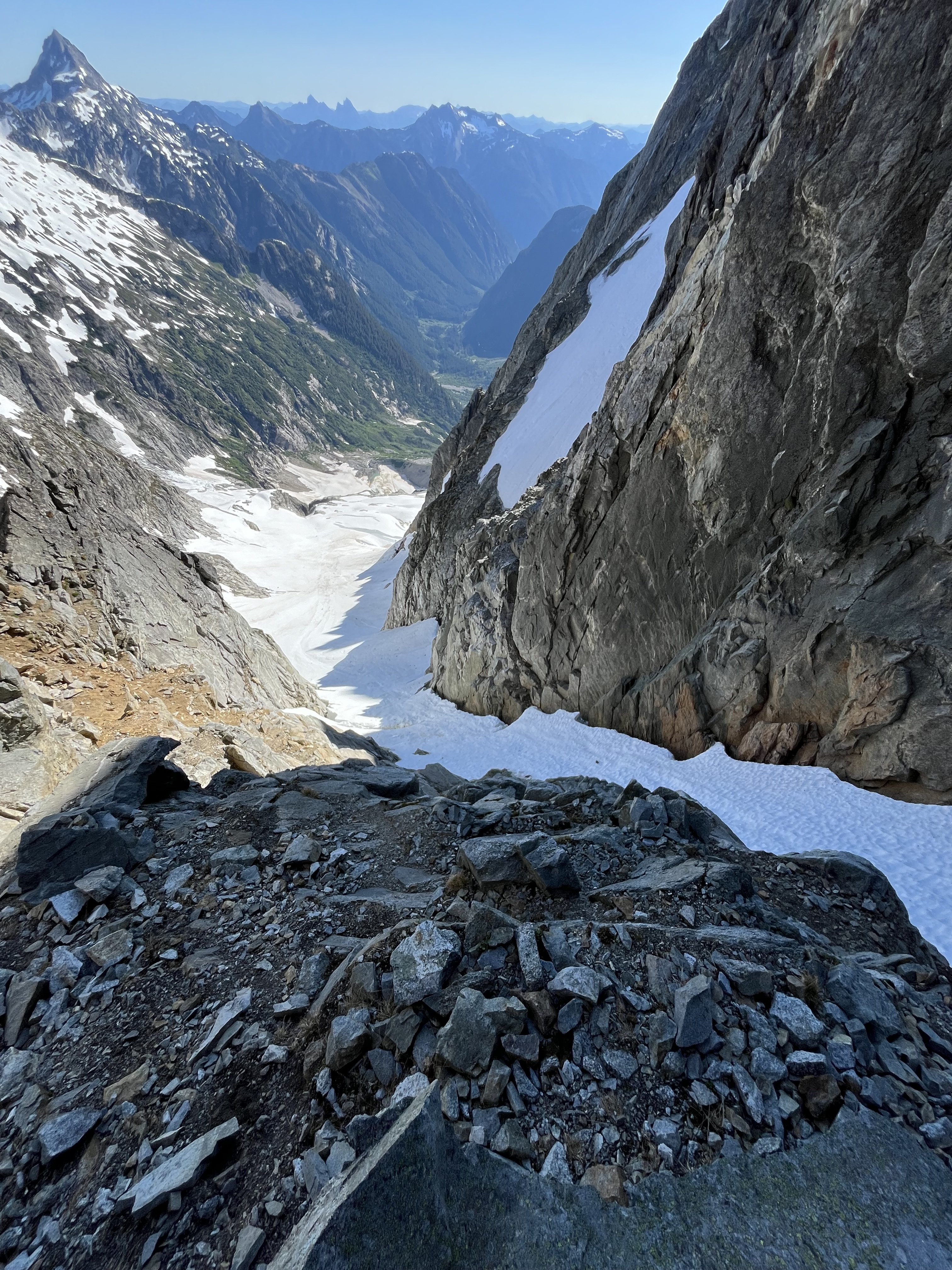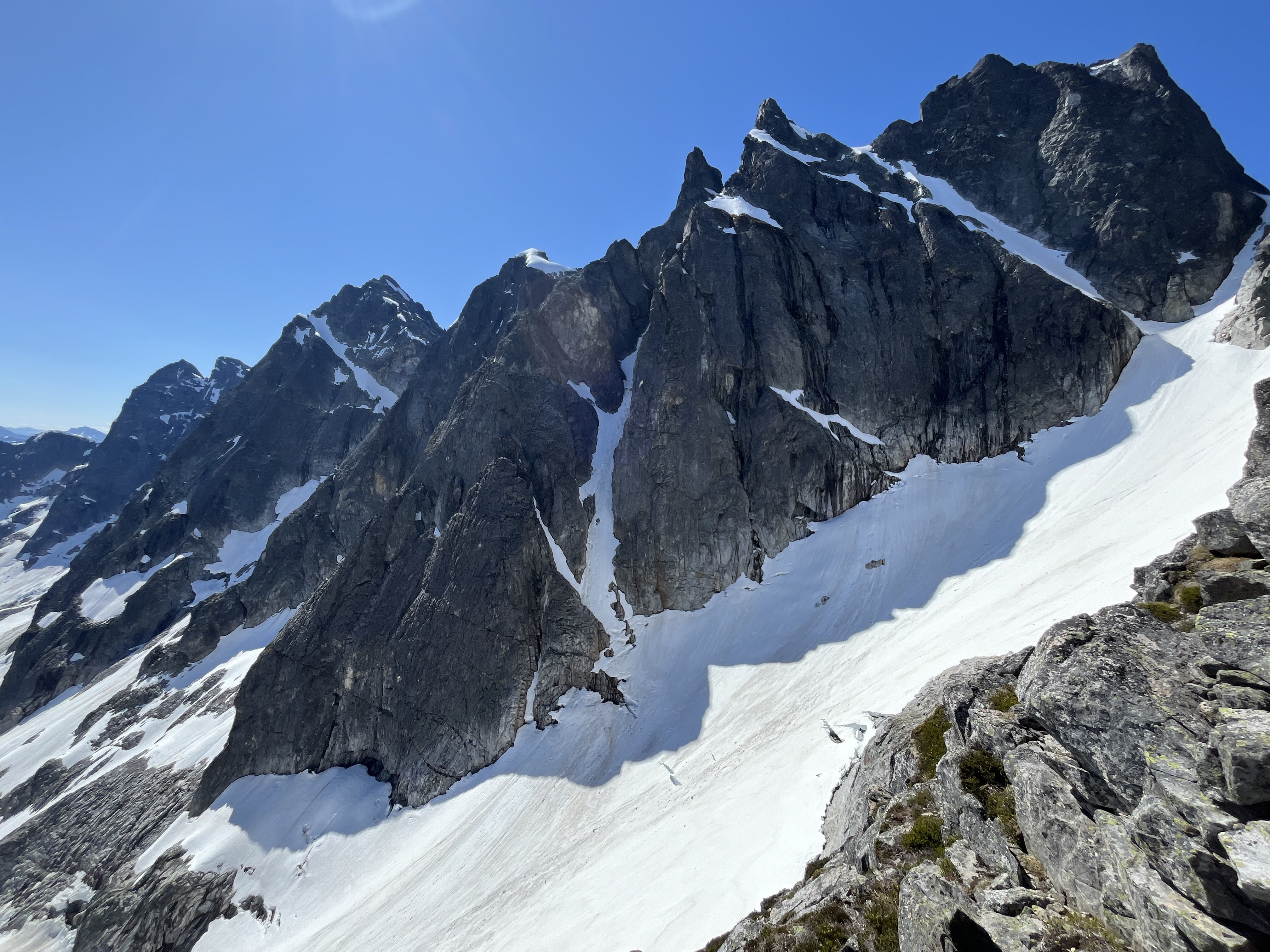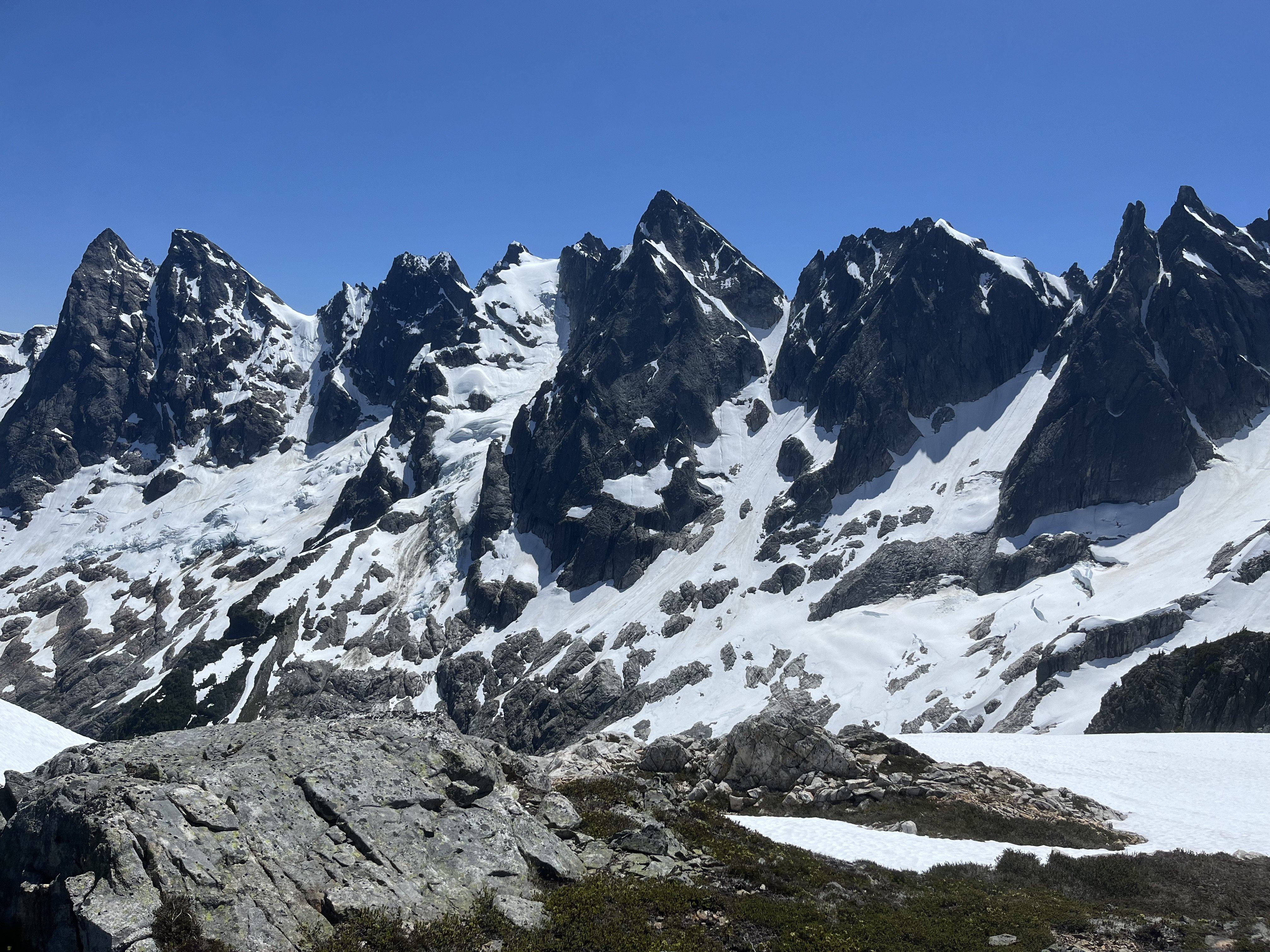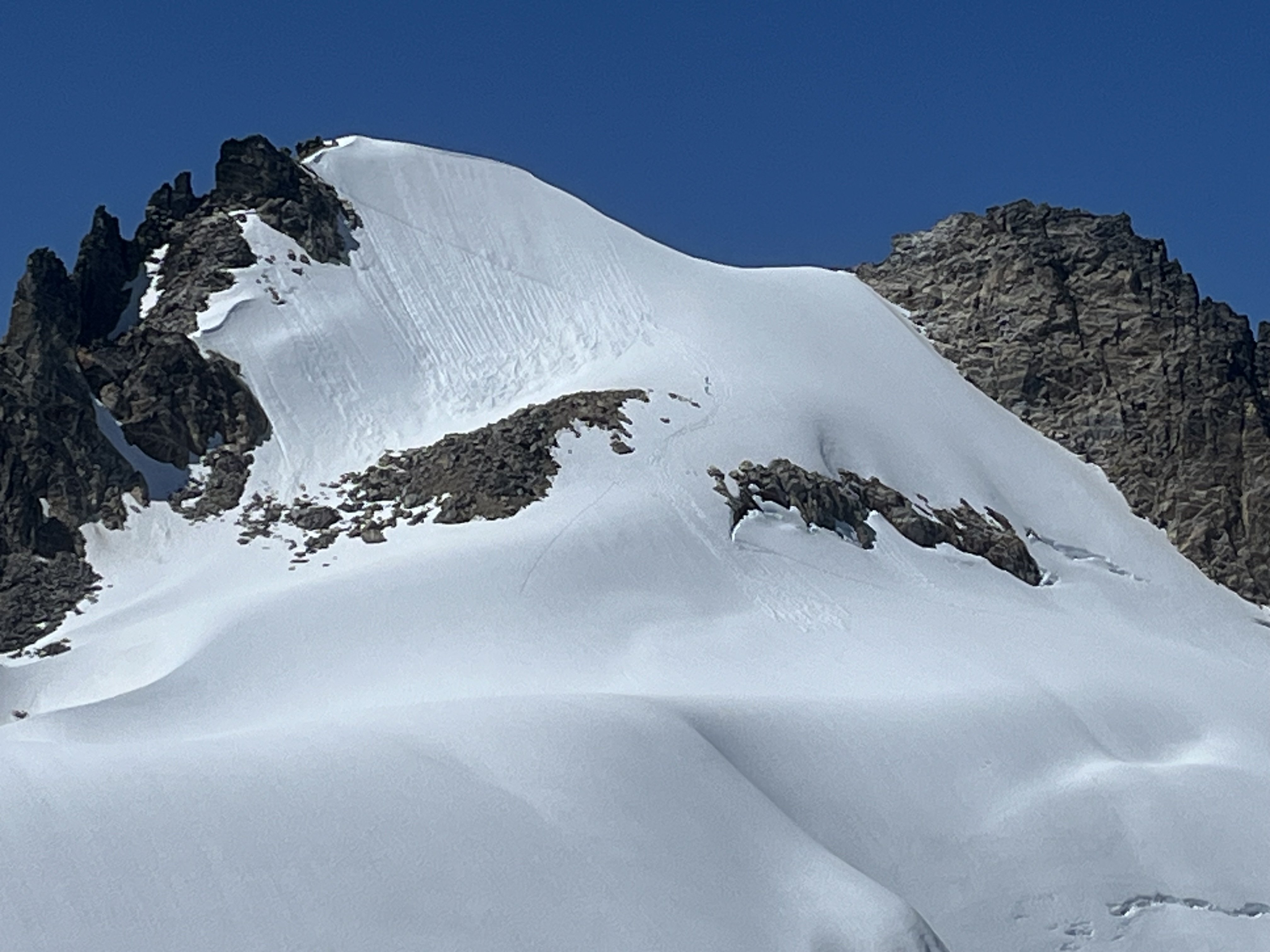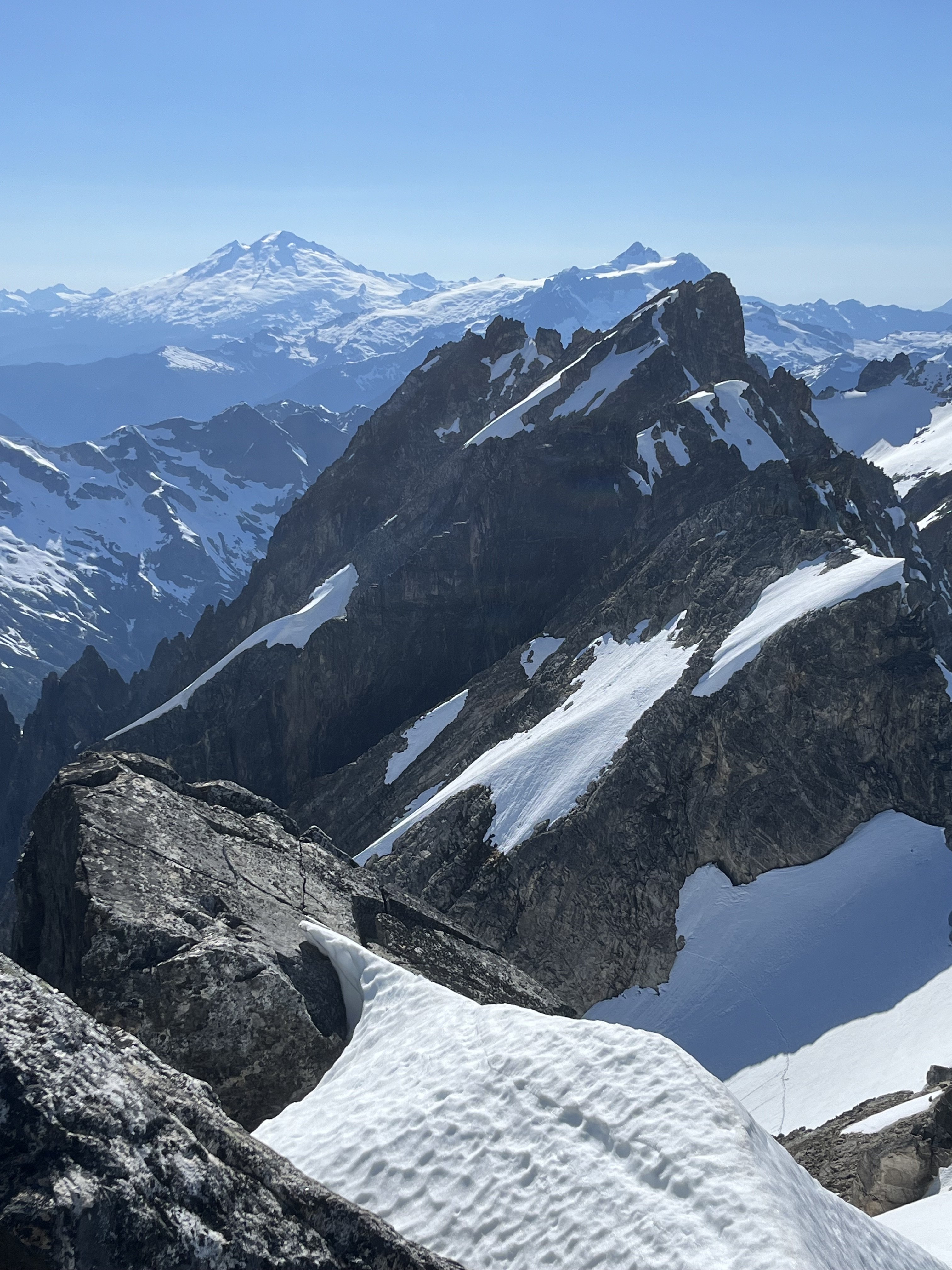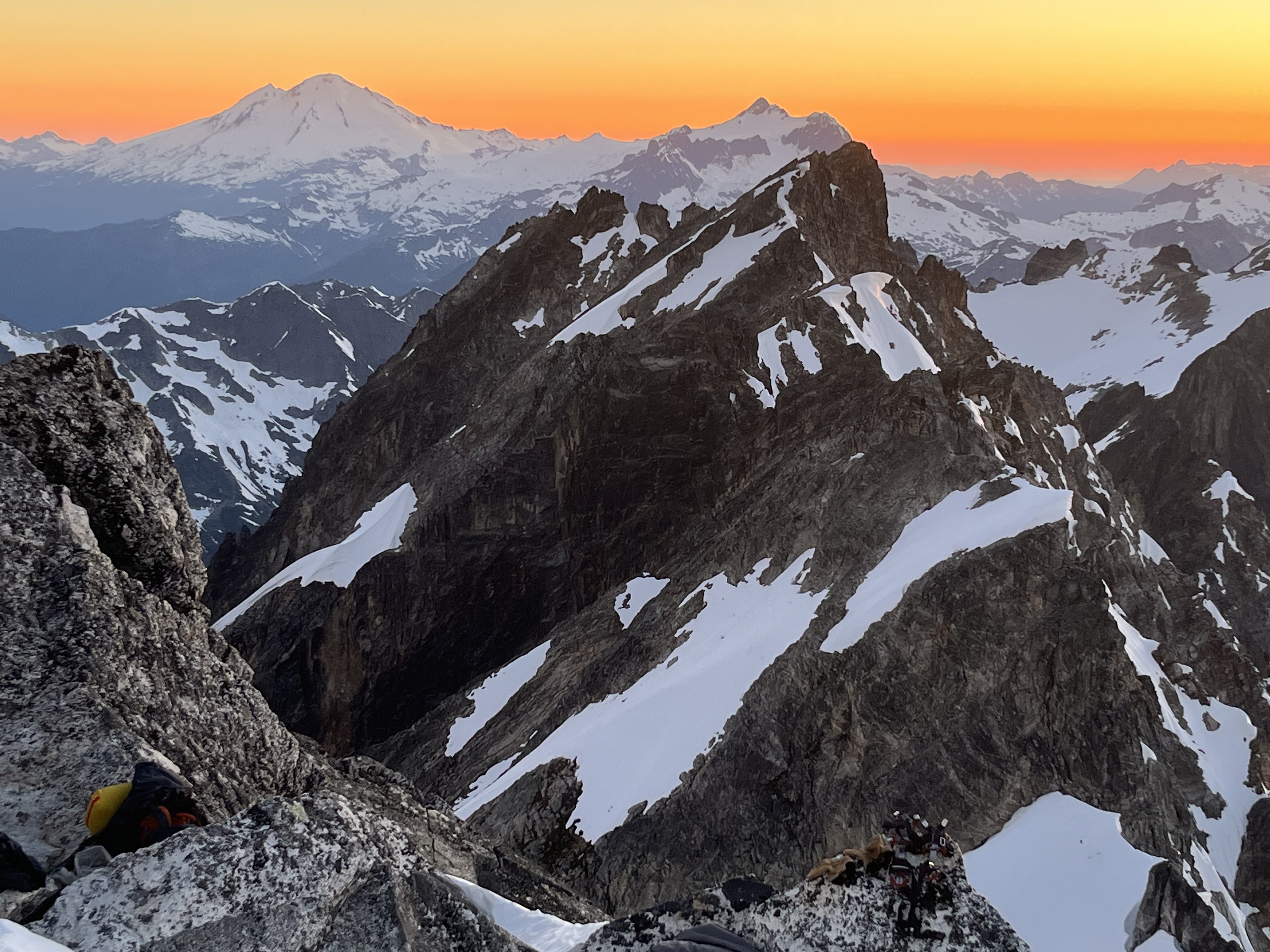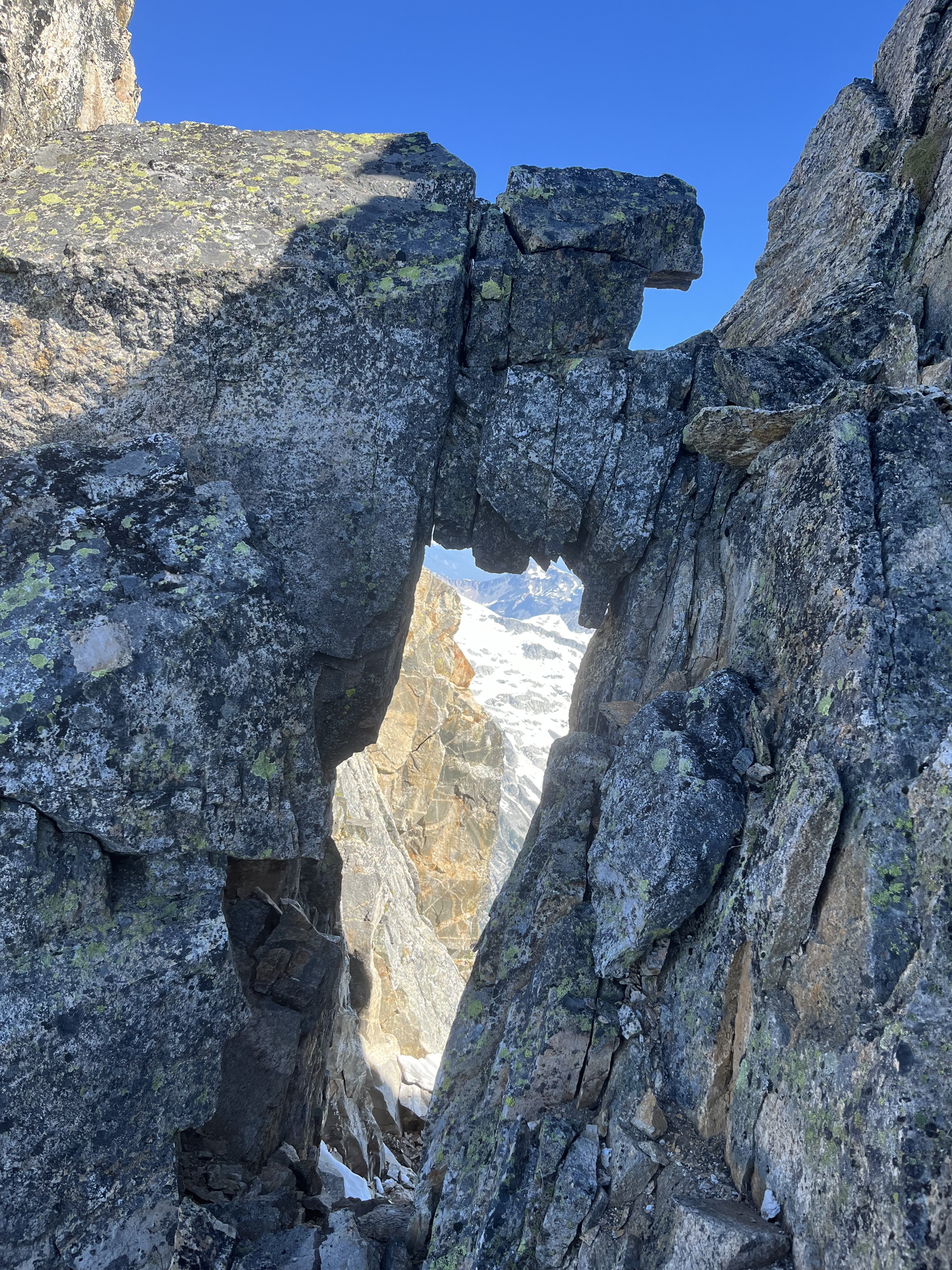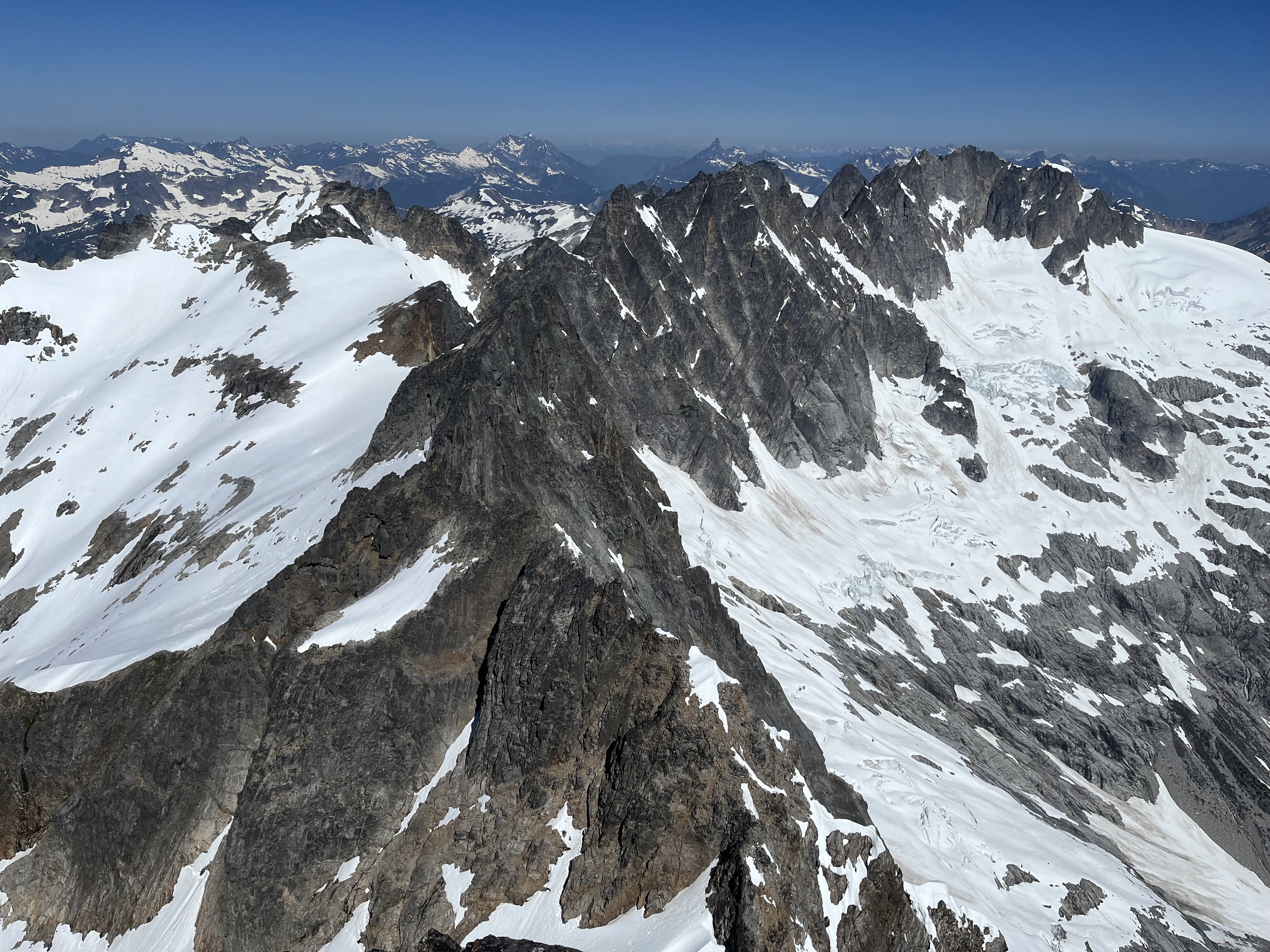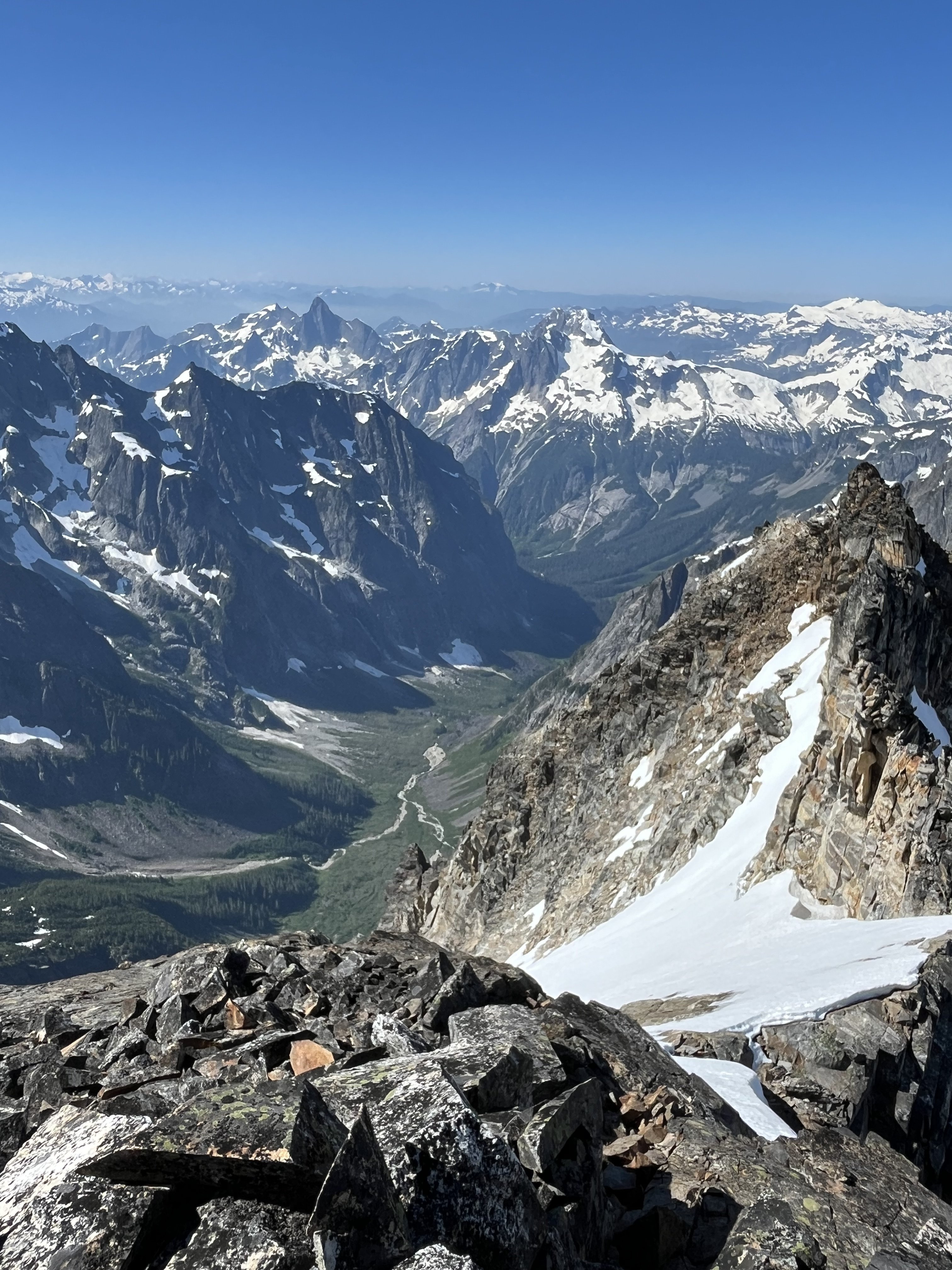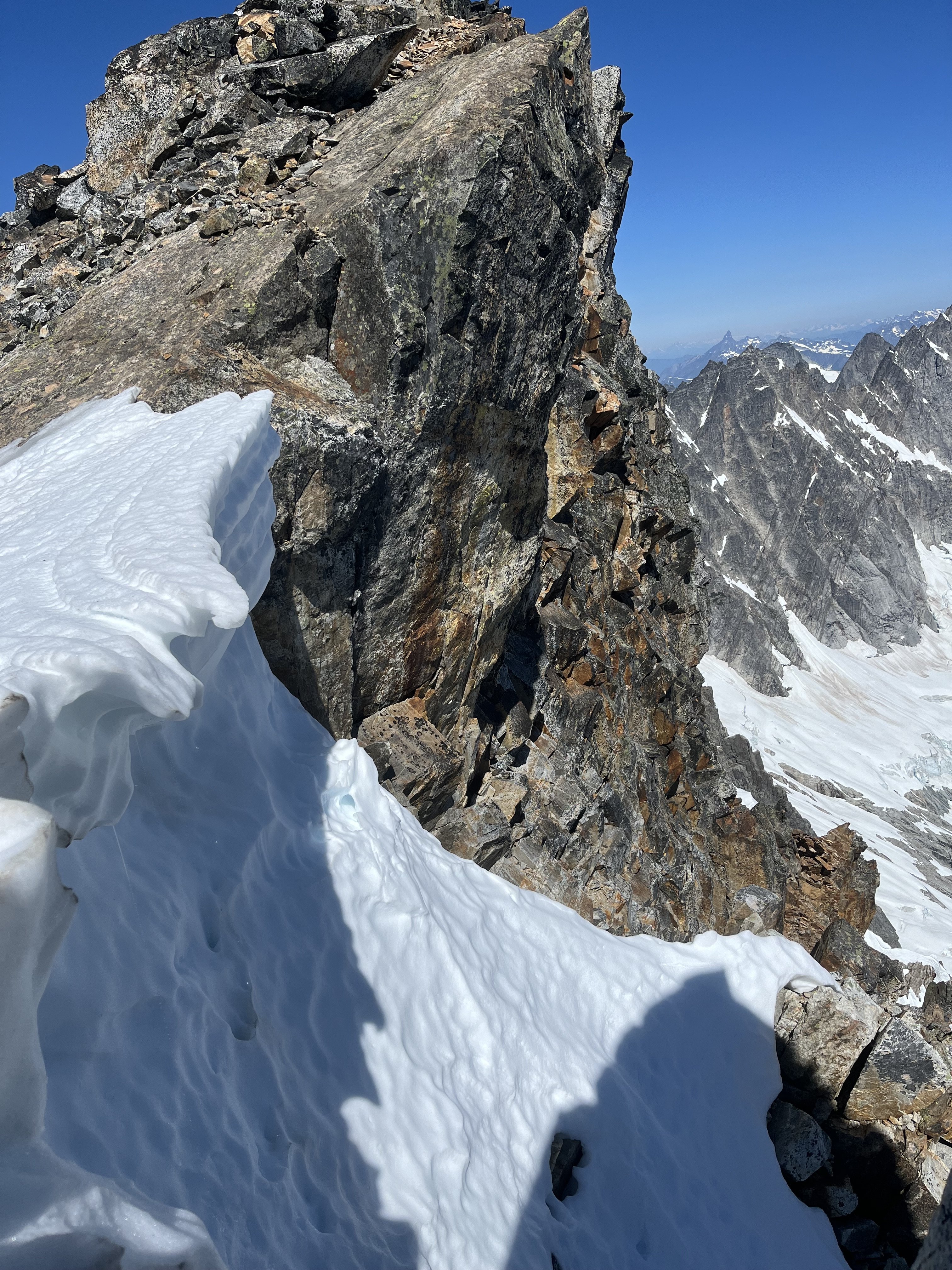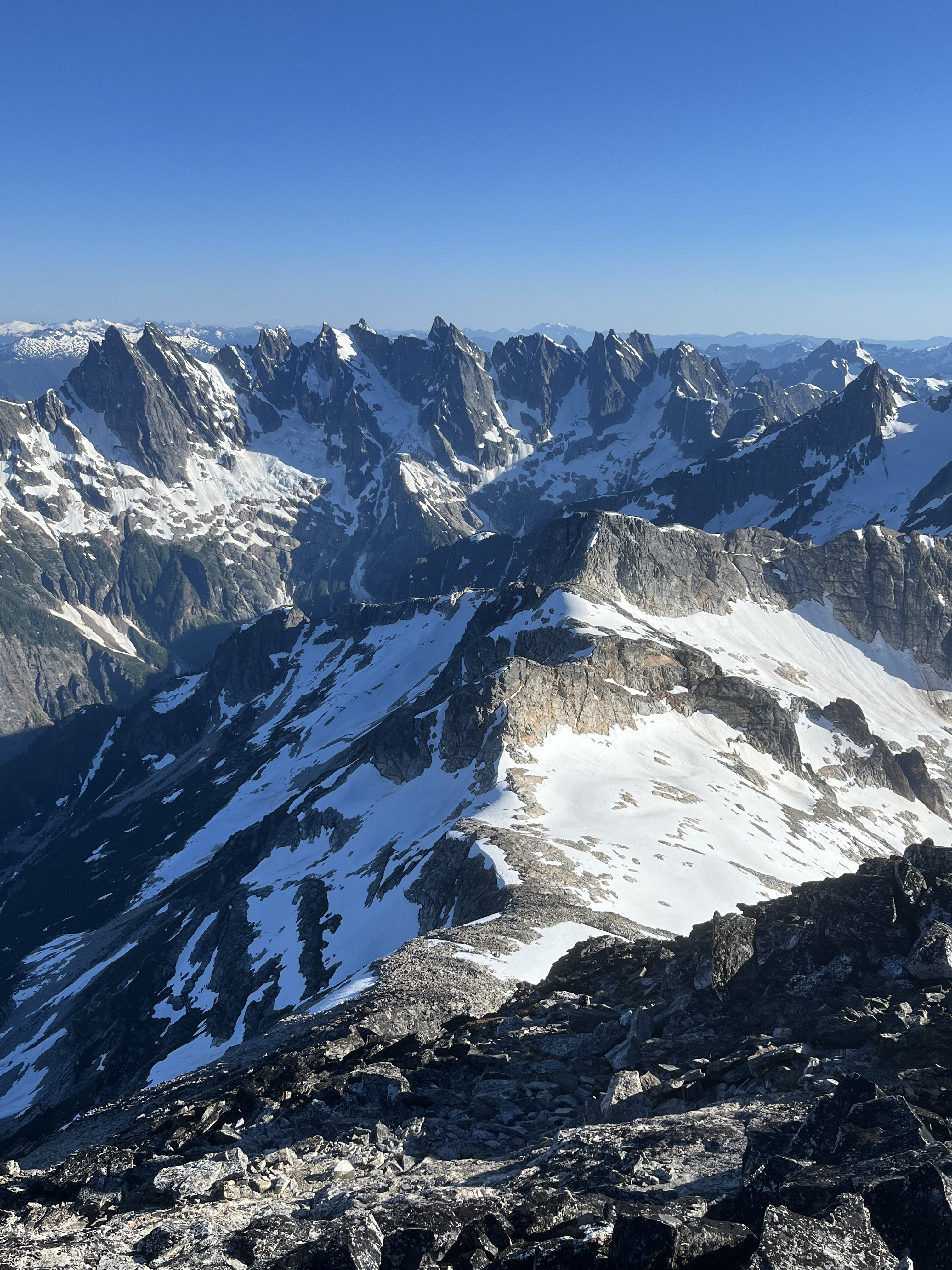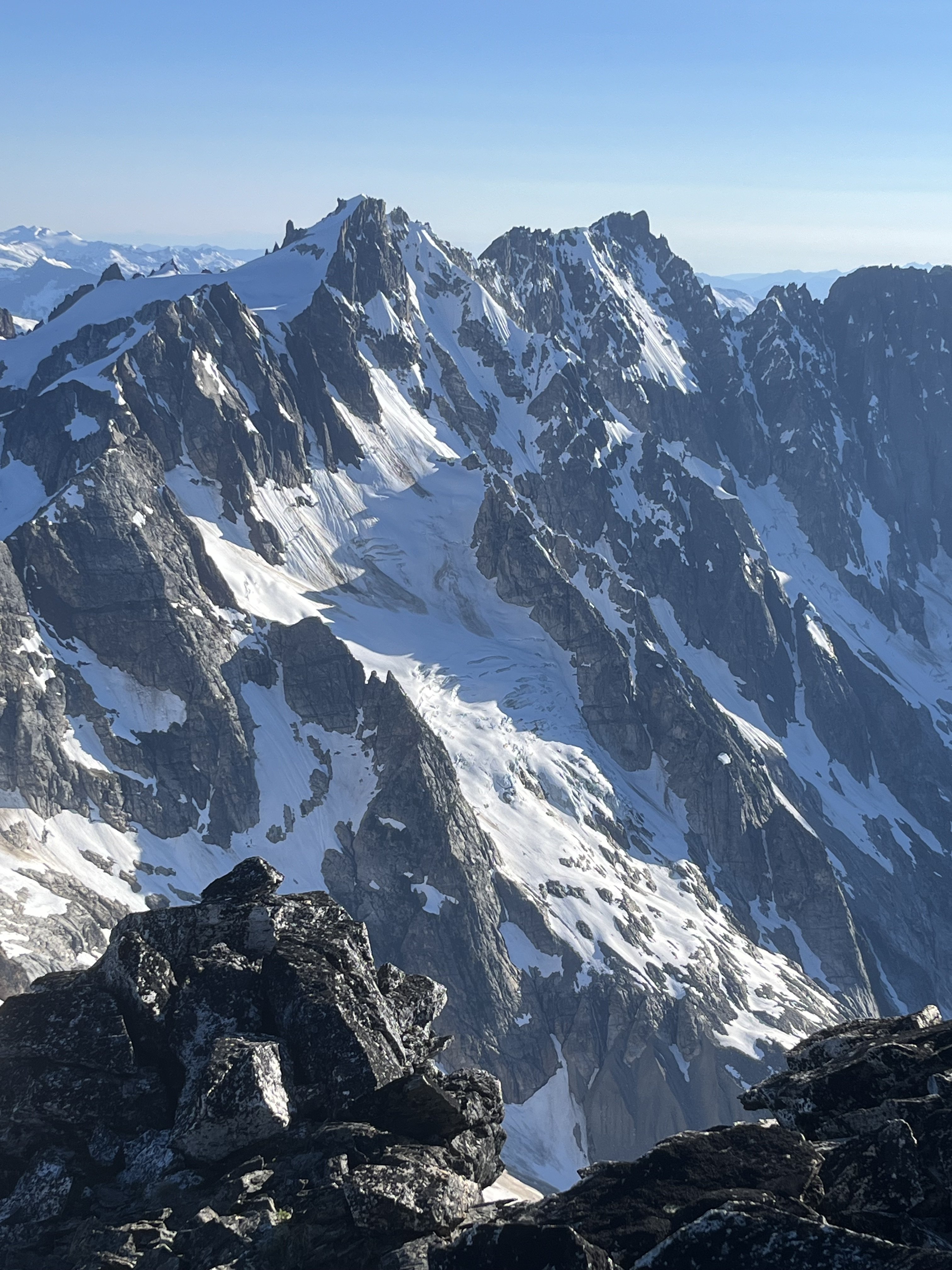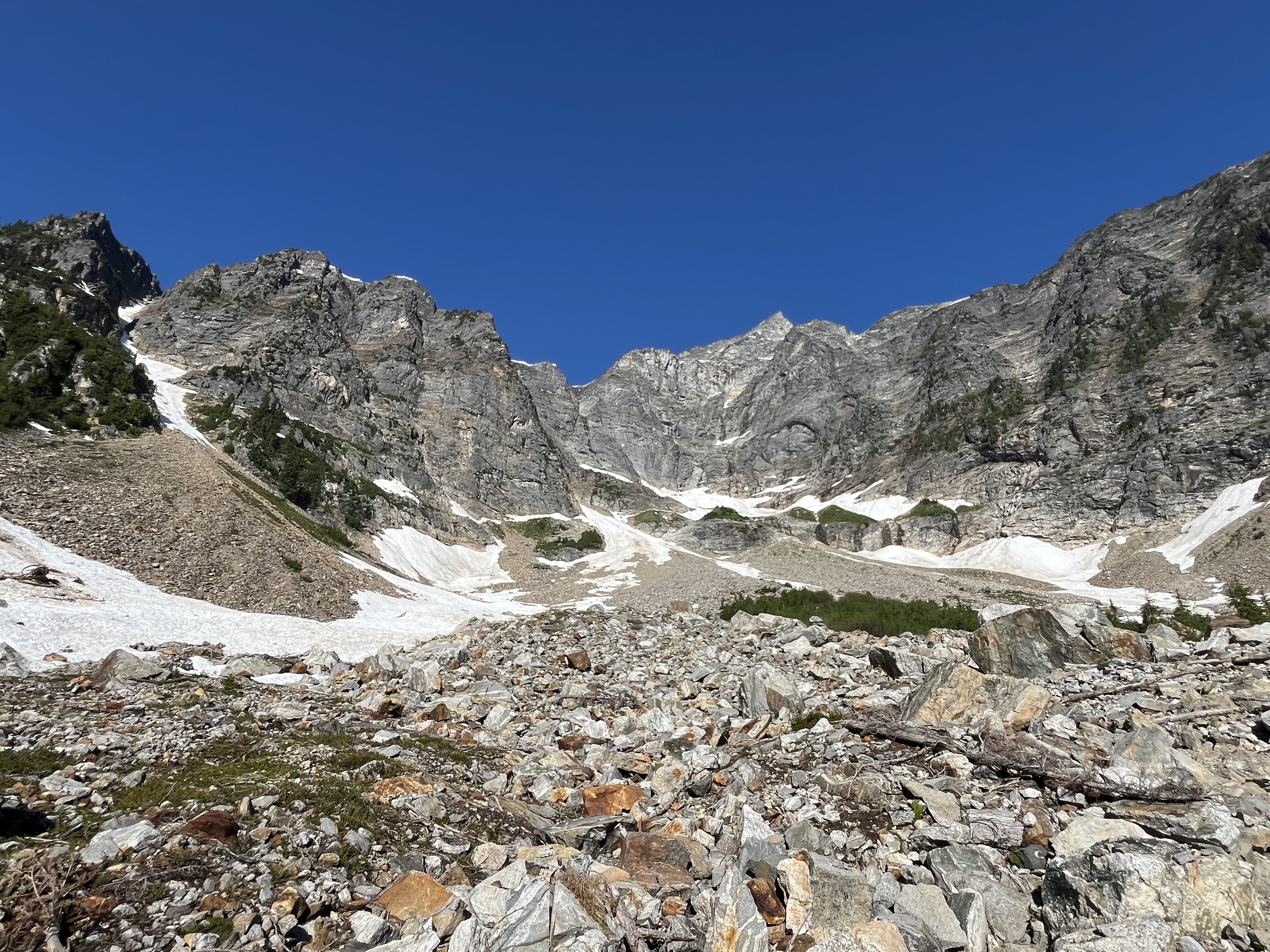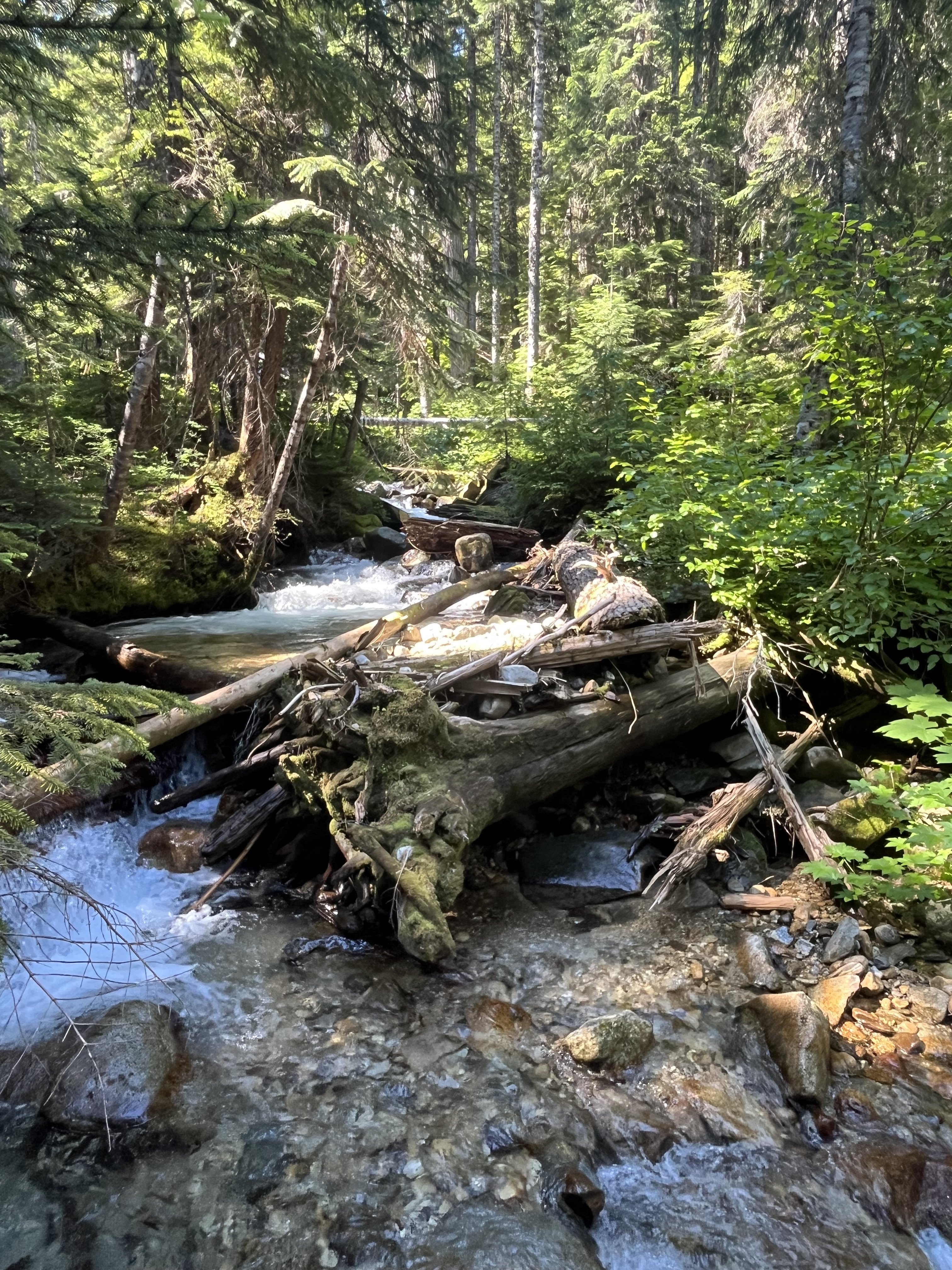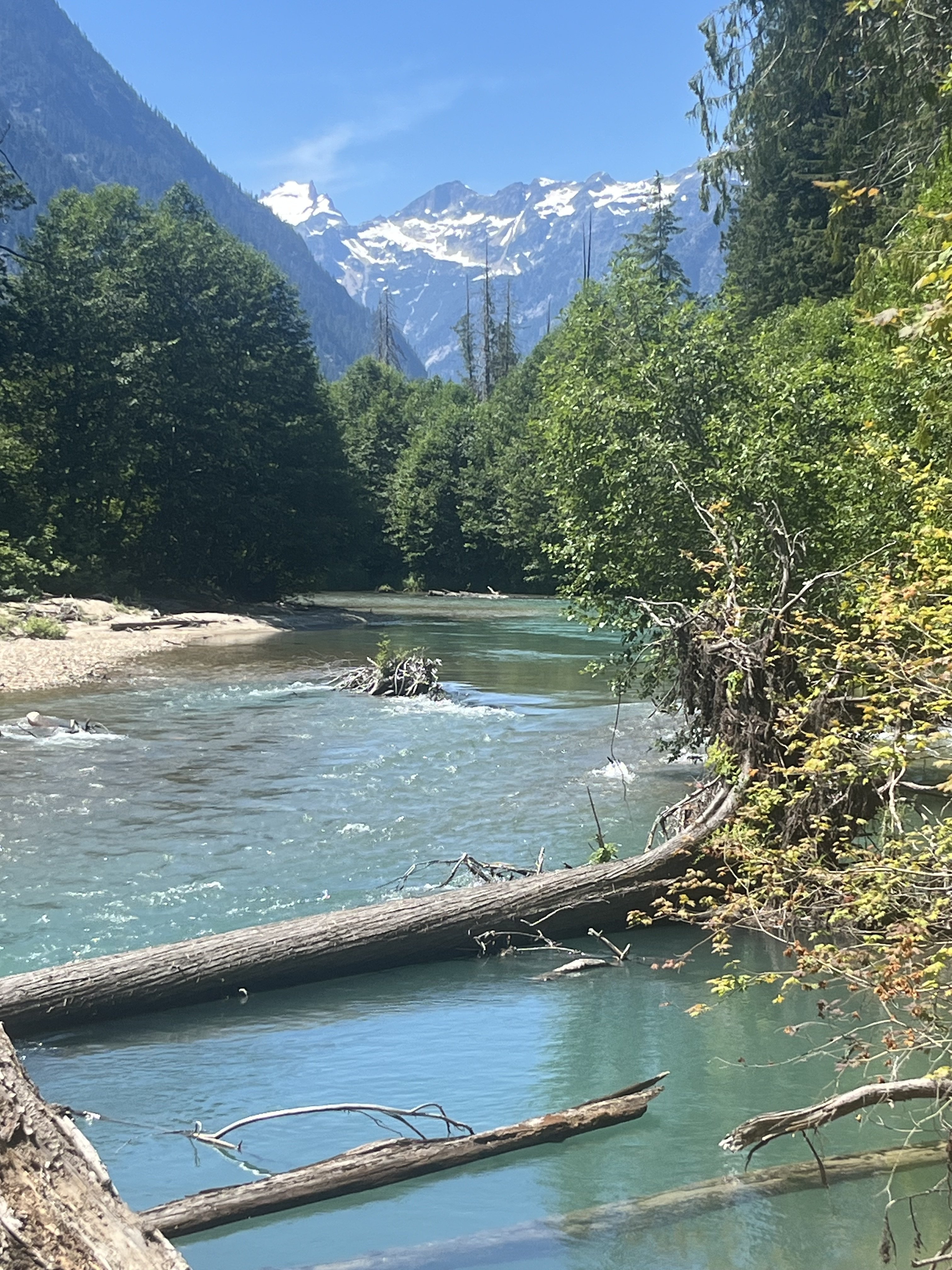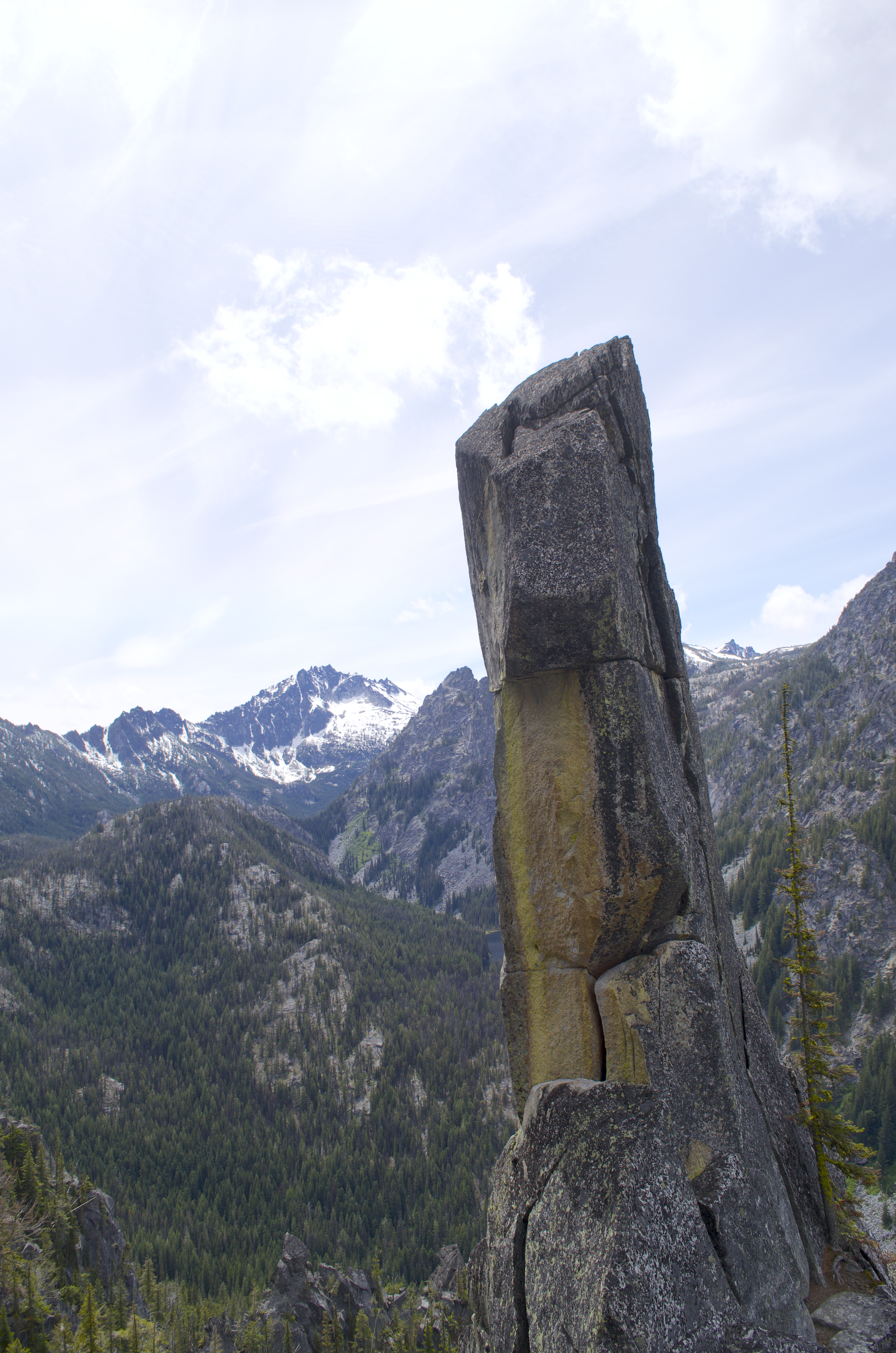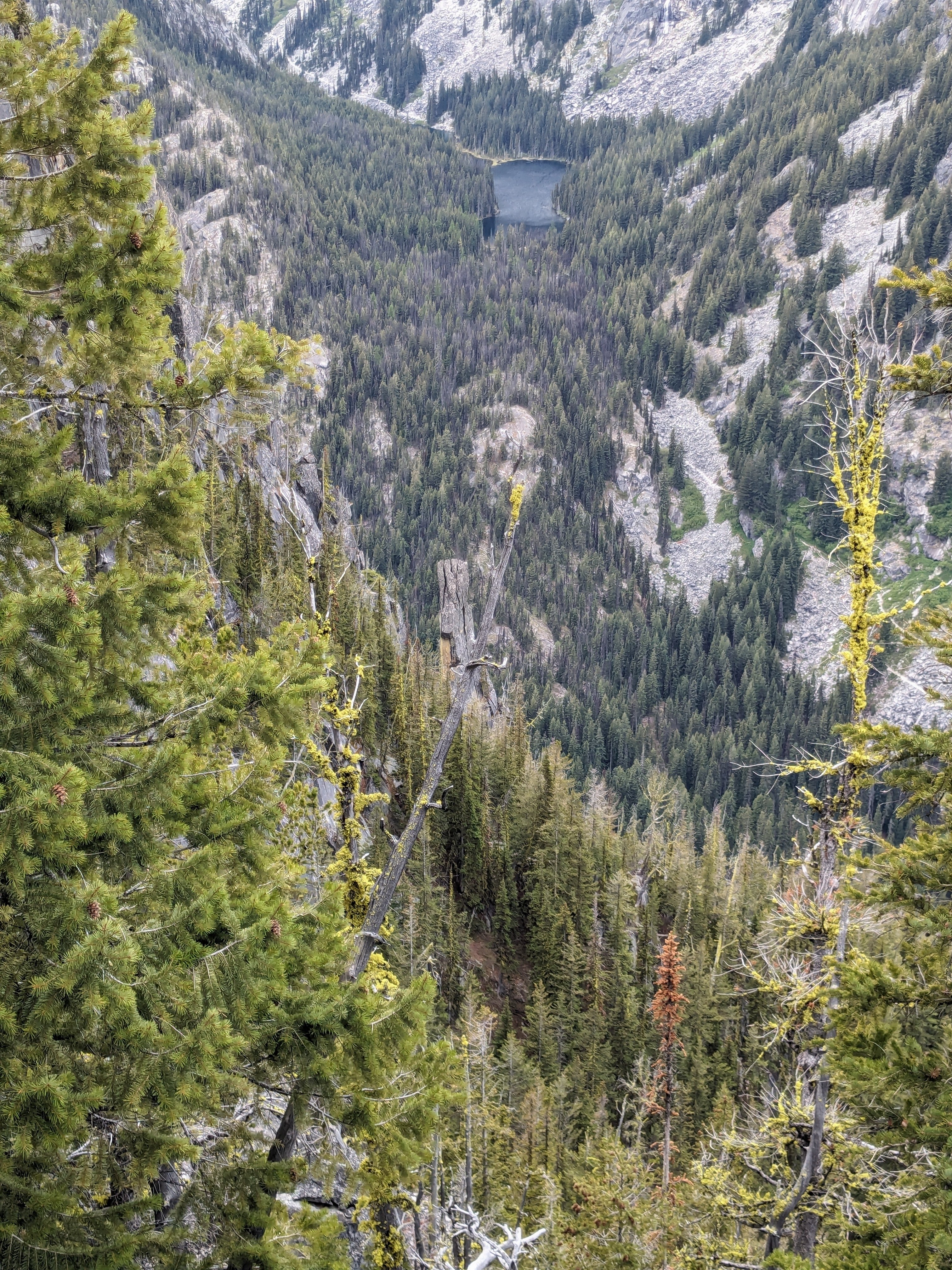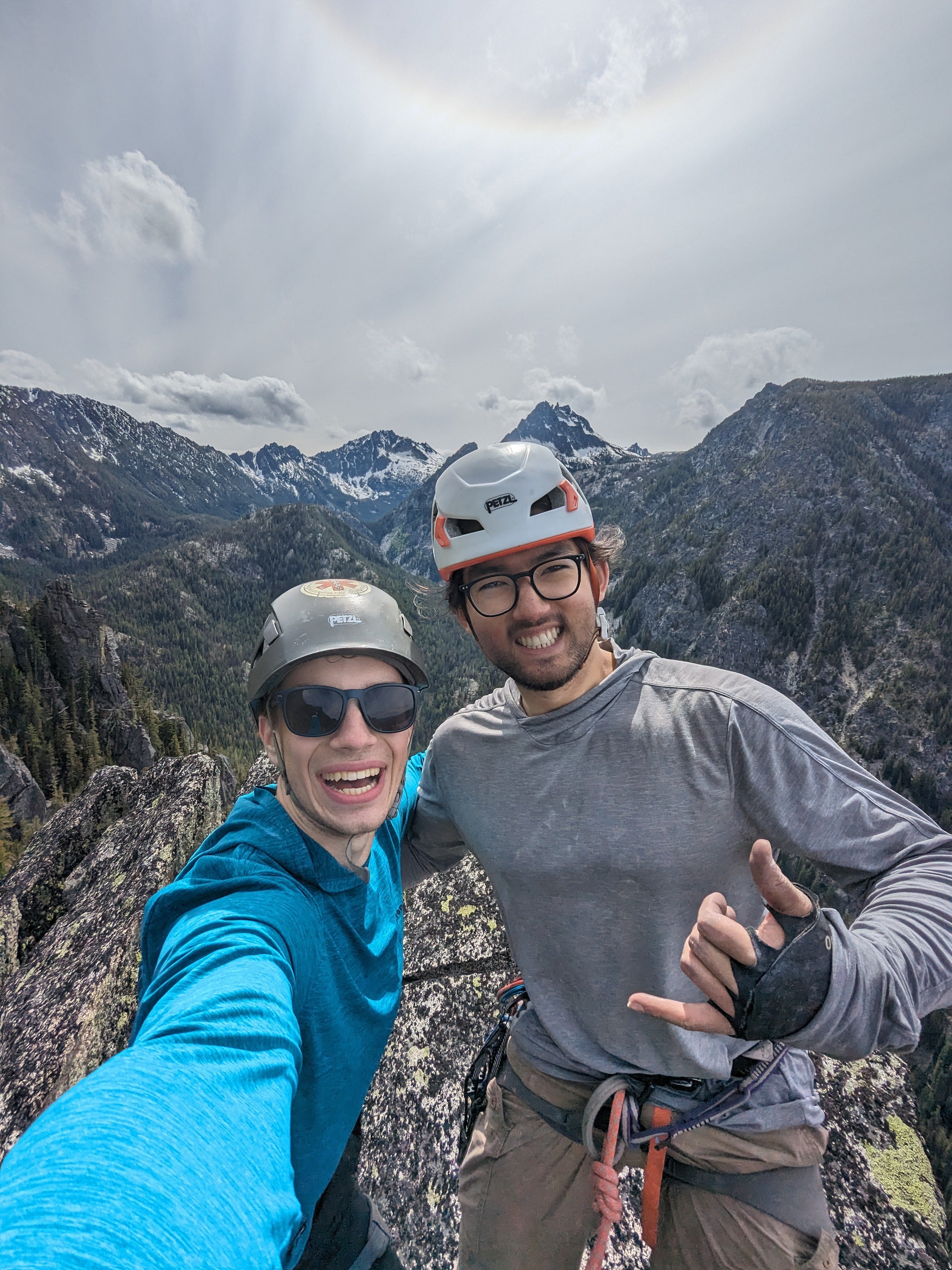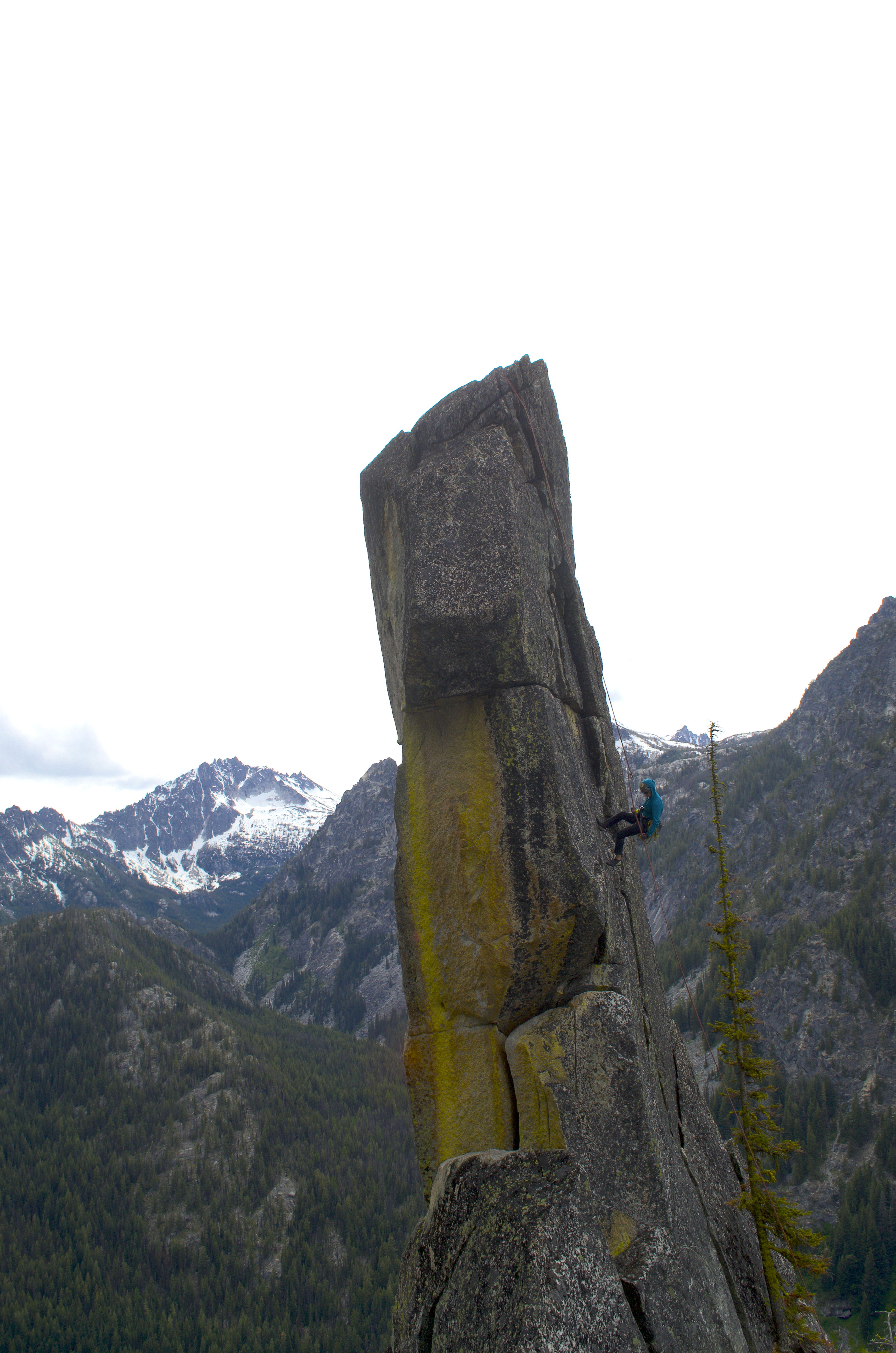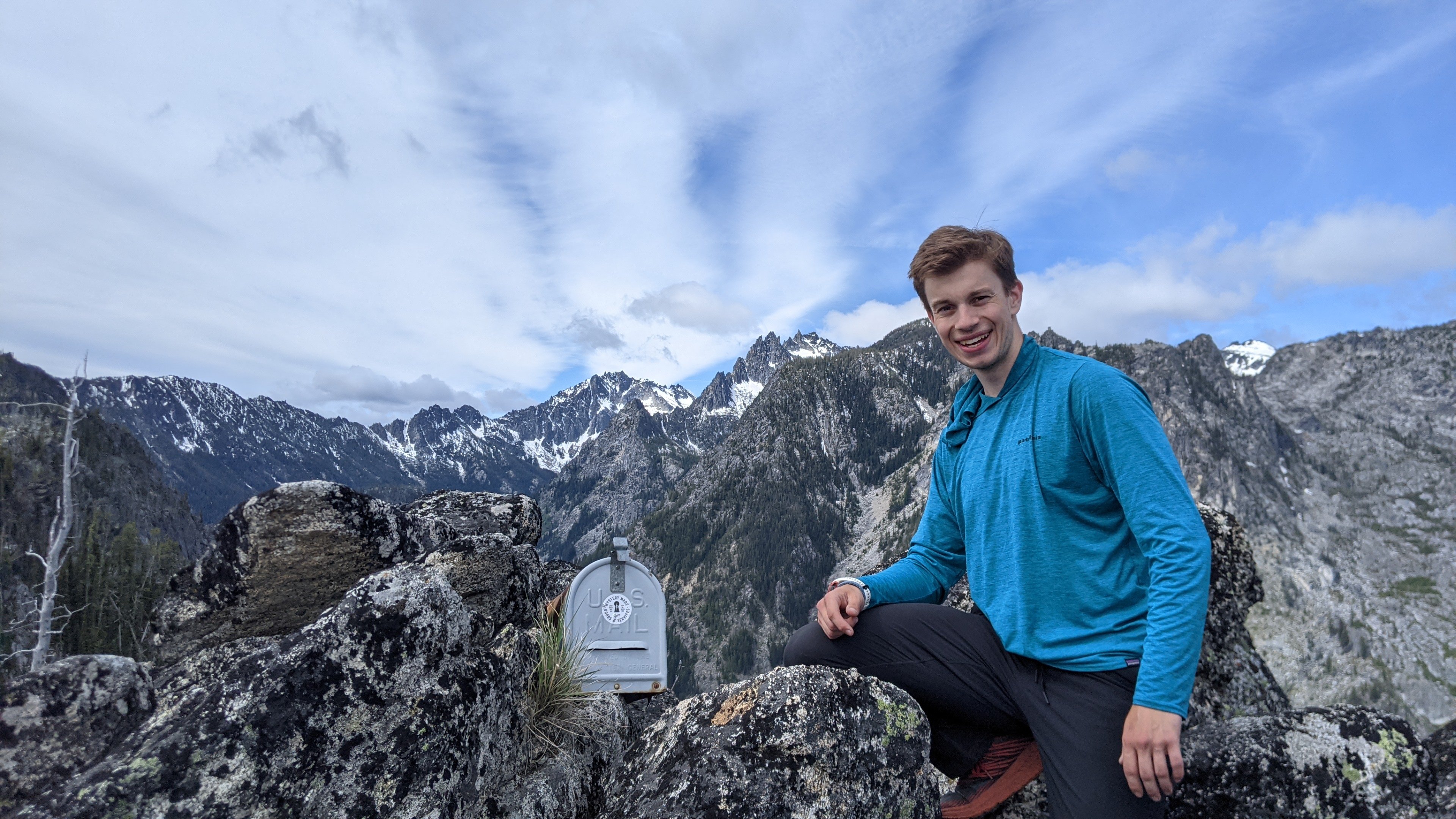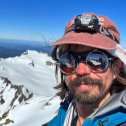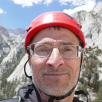Leaderboard
Popular Content
Showing content with the highest reputation on 07/10/24 in all areas
-
Trip: Pickets, some south, mostly north - Goodell to Big Beaver (abandoned Goodell enchainment attempt) Trip Date: 07/07/2024 Trip Report: Last weekend was a good time to get high and try to stay high. I set out with hopes of essentially enchaining the Goodell creek watershed. The idea formed gradually over the past few years as I noticed bits of beta here and there. The key pieces of the puzzle for me were a) seano’s solo ropeless descent to the NW from W fury, and b) that descending S from N Despair is apparently not difficult With this and other reports here and on Steph Abegg’s site I felt like I knew enough to attempt to solo with a bike drop at Thornton lakes TH, and entry at Goodell TH. The plan was to go up to O-H Col, on to Outrigger, to East then West Furies, down towards Pickell pass (visiting Swiss and Spectre along the way). Then Crowder, Pioneer, N Despair, hopefully find a good descent to its south, then regain the ridge and circle back for S despair, then back out Thornton lakes. Since I’d already climbed Triumph and didn’t want to pack a #4 all that way, it wasn’t on the list. But an enchainment including it would be more aesthetic. I would have enjoyed company but doubted I’d find anyone with the interest and time. At some point I deluded myself into thinking I could do it in 4 days. This wasn’t wildly off the mark but planning on 5 days would have been smarter. Long story short I didn’t complete the loop, and likely won’t repeat the part that I visited just for the sake of a loop. I haven’t seen anyone describe this exact variation of a pickets excursion. Still think it’s a cool idea, hope someone tries it out. It was at W Fury (just after being inspired by the fresh Mongo ridge entry from the day before) that I decided to instead bail East. This was partly due to falling behind schedule, but what sealed the deal was a cresting wave of snow guarding entry to the chute dropping off the N side of W fury, just east of the summit block. Maybe if I had a belay, but it looked too spooky to engage solo, quite a bit of exposure there. I had wanted to go early to make sure the snow arete on N despair was in good shape, and the bypass gully west of Crowder, in case the NE ridge looked too sketchy. But it seems I was just a little too early. Back to the beginning, various notes In chronological order - day1: There is currently no bushwhacking on the path of least resistance to Terror creek. The creek looked tricky but wasn’t. There is dry ground at the bivy spot. There was still a good amount of snow in crescent creek basin, but a little hard to say if it was friend or foe. The post holing wasn’t the stuff of nightmares, but was fairly bad. I must have tweaked my knee at some point because it started registering some displeasure quite loudly as the afternoon led to evening. This was my first concern for the loop plan, but ended up being problematic but manageable throughout the trip. Gully to O-H col was in good shape. It was getting late by the time I got there (theme of the trip). I grabbed my rock shoes and carried them as I wandered around the choss Ikea to get up Ottohorn. The rock scar has the one fun bit of climbing on the route and I guess maybe low 5th due to exposure, but it’s quite easy, didn’t need the shoes. Returned to the Col and had to take much care not to have my mat, bag, or bivy blow off the mountain in that wind tunnel. Not a very comfy place to stay. Day 2 - Moving slowly on the skiers left of the snow. Feeling the weight of the pack, the exposure, and the slippery dirtiness underfoot. Reached the snow and saw that I could skip the rap, though that could quickly change given the relentless heat. Maybe no longer true as of this writing. Finding my way from the upper Mustard area to the ridge leading to Frenzel camp was surprisingly complex. I encountered a lot of steep, exposed snow with uncertain stages of moat development. I had to stay cautious here. Abeggs photos were eventually helpful but it took a while to reconcile what I was seeing because of my earlier season snow conditions. Had coffee at Frenzel camp, filled up water and headed down. Did one rap at the bottom of that steep section. I started to notice bootpack going in my direction of travel. I’m guessing just one day ahead of me? [edit: turned out to be Kyle and co] Later at Abegg’s “30 ft rap” section (going the other direction) I found the rock looking a little less brittle just around to the right (east) side. Heavy pack clouds my guess, but maybe 5.5-5.6. Not easy with a pack. Outrigger turned out to be more of a mountain than it looks on the map. Descending towards Fury wasn’t too bad, but again surprisingly long. I saw two figures coming down East Fury. Later on I realized it was likely these guys. I tried taking the ridge up towards East Fury (Abegg quotes someone claiming this can be done) but ended up cliffed out and reversing half of that and rejoining the boot pack on the glacier. I was lucky to have lots of tracks to follow all the way from here to W fury, and beyond Luna. Must have a relatively busy time in this zone. At the summit of East fury I realized it was too late to continue, I had no realistic chance of getting to Pickell pass before dark, especially if I wanted to climb Swiss and Spectre. It still seemed not impossible to catch up the next day. So I decided to rest and enjoy the absolutely exquisite location. Unlike the O-H Col this time and place was totally calm. (zoom in for 2 climbers descending between rock bands) Day 3 - another slower start than intended. The climbing along the way to W fury is generally shitty though not terrible, and occasionally fun. I was glad when it was over and worried that I had already burned a little over 2 hours. I was entertained to see more love in the summit register for W fury in the past few years than in the before times. Choss must be getting sexy. In my haste I skipped reading the poems packed in there, which I now regret. I backtracked to find the chute mentioned by seano. Surveying it for a bit, I realized I was now on plan B. I labored over back to East Fury, somehow taking longer than on the way to West despite no raps. Carrying the 4 day pack back and forth was futile but I don’t regret keeping the dream alive for a few hours longer. From East I followed boot pack down the glacier, over shoulders, eventually to ledges cut by steams, and a brief uphill to the ridge leading to Luna. As it was plan B I had not as much beta here, and I was pleasantly surprised. Amazing views on both sides, and fun hiking. Also a little bit subtle. I cliffed out again a couple times, just when I wasn’t paying much attention to the gpx I was glad to have. At Luna Col dismounting my backpack from its perch felt like liberation. In the warm evening I carried almost nothing up Luna. I was vaguely under the impression that it’s a choss pile, which is not untrue. But it’s the good kind, very easy on the feet. No steep dirt gullies or loose chunky talus. And another surprise that I was surprised to have - the narrow ridge traverse between false and true summits was just super fun. I don’t know how I wasn’t aware of this one. After melting face for a bit gazing at Fury, into the cirque, and the S pickets I returned to my burden and continued descending. At a dry knoll the mosquitos formed an personal exoskeleton and motivated me further down. I plunged down snow that was still soft in the warmth of the late evening, then a little bit of ice (worms everywhere) then another gully (where a small stream disappeared underground and reemerged lower down), finally finding flat ground in the sandy bottom east of Luna after dark. I processed the past few days then. The character of the environment continually changing with elevation is always one of the most attractive things about alpine trips. That aspect was far from new. But the intensity of it was so much here. To be up on Fury and witnessing its elemental austerity give way to water and flowers and choruses of more waters, and so on, really got me. I think it was the impression that In the many faceted character there is also a unity. It’s all just there doing its thing, indifferent to us visitors, and doing it perfectly. (scale isn’t obvious here, and the photo is tilted about 15 degrees. This is where I elected to not find out) Day 4 - some talus and stuff and then a little jungle, but not much alder to contend with if you stick to the easiest path, which is sometimes faint and easy to lose. More schwacky then the approach to Terror creek but far from the worst. As I’m getting lower in elevation the thermal gradient is amazingly sharp near streams. It briefly feels relieving to pop out on a trail again, but the reality of banging out a bunch of miles on fumes in high heat sets in. I’m hoping to get to the dock early enough to maximize my chance of hitching a ride across the lake, and from there hopefully back to the Goodell TH. With perfect luck that’s exactly what happens. I find 2 climbers waiting for their boat scheduled just a half hour after I reached the dock. Veterans of the pickets both, I enjoy hearing of their 6 day outing and pickets traverses 30 years ago. I quote directly regarding the approach to Terror creek: “if there was a trail back then, we didn’t know about it”. Epilogue: I am so hungry, and my feet look like they’ve been mugged. Gear Notes: Whippet, rap line. Shoes, slings, nuts carried but unused. Approach Notes: Goodell3 points
-
Trip: Snow Creek - The Chisel (North Face, 5.9) Trip Date: 06/14/2024 Trip Report: After stumbling across Jplotz's photos of the Chisel on SummitPost taken in 2006, I was inspired by the aesthetics of this pinnacle and the lack of information about it. (Edit: I found JPlotz's CC post shortly after writing up my own report! Turns out their ascent was in 2004.) Jplotz, 2006: The photo that captured my imagination Photo from 6/14/24 Working with only the 2006 photos, a brief mention in the Cascade Alpine Guide, and a location pin on Caltopo (later discovered to be inaccurate) my buddy Sam and I set off for a Cascadian adventure. We approached via the Wedge Mountain Trail, bushwhacking and scrambling south along the ridge to the point where we would drop down into the 4th class terrain and descend the 500 feet to the base of the Chisel. The bushy ridge of Wedge Mountain, looking north. The tower in the middle is not the Chisel. In hindsight, the more sane approach is to take the Snow Lakes Trail and ascend a gully (unless you have a hankering for a scrappy, scrambly day out) even though the mileage and elevation gain are higher. This way, you can avoid most of the schwacking, the loose descent off the ridge, and the heinously overgrown road to the Wedge Mtn. Trailhead. The second crux of the day (the first being the road) was locating the Chisel. Caltopo's pin is about 400 feet too far north, and this caused some confusion as we continued down the ridge with no Chisel in sight. After traversing a little farther and scrambling up to a viewpoint, we finally laid eyes on the pinnacle and felt a mixture of stoke and worry as we realized how much kitty litter and pine needle-strewn 3rd and 4th class terrain we would have to descend to reach our objective. The Chisel reveals itself! We hemmed and hawed for a few minutes, then started carefully down-scrambling. We made one rap off a tree, then roped up and traversed south across a dense 45˚ forest slope, using the trees for a natural running belay. Just when it felt like we must have passed the formation, Sam shouted back to me that we were close! Soon we were back on rock, scrambling to the base of the climb. We took a short break to settle in and rack up, then started up the real climbing. I led the first short step to the big belay ledge, a hand crack behind a flake. Up next was the 75' 5.9 pitch that I had seen referenced but never photographed. I was surprised by how protectable and high-quality it looked. 75 feet of 5.9 crack! I started up the wide layback, noting how much the lichen-crusted rock reduced the friction beneath my feet. At a good stance, I placed gear and moved into a section of good hands followed by good fists. More laybacking on flakes and solid gear led to the final section of hands with increasingly abundant and positive face holds. Topping out, I whooped with delight and stoke on the fun lead and spectacular position. I brought Sam up, and we took a moment to enjoy the views and take photos. There are three bolts at the top, an assortment of rusty 1/4"ers. We replaced the old tat and equalized the two best bolts, backing them up to a nut. Woohoo! Sam on rappel The scramble up and out was straightforward enough, though accompanied by many laments of the Wedge Mtn approach. Burgers in Leavenworth capped off an unforgettable day out! We initially believed we were the first to climb this feature since 2004, but the JPlotz TR reported a hole count of one at the summit and we found three. If you climbed the Chisel after 2004 and before us, reply and tell us about it! The little summit block of Wedge, a small bonus on the day Gear Notes: If you want to sew it up and have a solid anchor: Singles 4 to 0.4 Doubles 2 to .75 Approach Notes: Wedge Mountain approach is much more bushwhacking and scrambling. Snow Lakes Trail is probably much more straightforward than what we did, but longer.3 points
-
Trip: Mt. Fury - Wayne Wallace’s Mongo Ridge (Second Ascent of the Rooster Comb and new line on the Pole of Remoteness) Trip Date: 07/07/2024 Trip Report: Once in a Lifetime: Wayne Wallace’s Mongo Ridge (Second Ascent of the Rooster Comb and new line on the Pole of Remoteness). VI (26 Pitches, Steep Snow) 5.10a+ R. [not to dispute or change the current ED 1 5.9 rating, proposed by Sam Boyce. A note on the grade: 1. we encountered climbing harder than 5.10a on tower one--this could be avoided with better route-finding 2: Wayne gives a grade of 5.10 on tower three with the description of an "overhanging bulge" that matched our experience. We are in agreement that there are multiple ways of lowering the technical climbing difficulty, as Mongo Ridge is itself full of lines, and are quite honestly not concerned with the naming of difficulty or grade. The experience is full on, and the "hardest" pitches usually get low technical grades--5.4 Tower 3 traverse.] 65 hours on the route (30+ hours of climbing and three bivys), 6 rappels, 3 simul pitches, 1 big bag of Chad’s Backcountry Catfood. Adam “Mo” Moline & emilio Taiveaho Peláez Itinerary: Monday July 1st: Drive and boat-in, walk to Luna Camp Tuesday 2nd: Luna Camp up Access Creek Wednesday 3rd: Below Luna Col to ½ way up Tower One (travel low route, below Luna Ridge, summit Fury, descend; sleep at tower one bivy) Thursday 4th: Tower One, Tower Two, Tower Three; sleep at tower three bivy Friday 5th: Summit of Tower Three to False Fury Bivy (climb Tower 4, Rooster Comb, Pole of Remoteness) Saturday 6th: False Fury to True Summit of Fury, traverse back through East Fury and back to Luna Ridge Bivy Sunday 7th: Luna Ridge down Access Creek and hike back down Big Beaver to HWY 20 Concise Version: A celebration of Wayne Wallace’s achievement on soloing the mythic Mongo Ridge. A rare opportunity and ideal weather window, following the wake of a week spent in the Chilliwack range for the wedding of a lifetime. Adventure, friendship, gratitude, the closing of a four year project, renewed vigor and commitment to wildness and to the power of cooperation and trust. Our line up The Pole of Remoteness (“Once in a Lifetime” 2 Pitches, 5.9R) is accessed by climbing the Rooster Comb and rapping climber’s left of the formation, then following an upward gulley to an opening near the base of the Pole before traversing onto the ramps comprising its south facing aspect (see P.24-25 for additional details/beta). Thank you to Wayne Wallace for the line. The boldness and grit of onsight free soloing Mongo Ridge, only rope soloing the hard climbing of tower three, is astonishing. Words fail in capturing the admiration we feel in imagining being on the ridge without beta, committing to each challenge--each tower, each pitch, each move--without certainty of outcome. As we mention in the trip report, our effort is but an echo of that awesome event in 2006; thank you to Jeff and Priti Wright for their second ascent and trip report (this trip report motivated us to attempt Mongo for the first time in 2022, and we’ve poured over it for years); thank you to Lani Chapko and Sam Boyce for the third ascent beta–including the idea to luxuriate on Tower Three, the “sick bivy” was indeed the sickest bivy of my life–and thank you to them for their second ascent on the Pole of Remoteness, for cleaning our rap tat during their climb (and a cam I think?); thank you especially to Jake Johnson, secret hero of this trip report, who selflessly gave us gear, helped us think through the logistics, and who climbed with us in spirit, hoggin’ all the leads with his enviable trad dad style even when he wasn’t there, we were redpointing Tower One because of him; thank you, too, to Cedar Wright for the nice gear and rain jacket that I’ve been living out of in the backcountry, sleeping on top of ropes in the open air but feeling like I got a tarp on; thank you to our families for the continued support and love and openness to allow us to pursue this lunatic dream; and mostly thank you to the Picket Range, for providing us passage, for testing us, humbling us, and endlessly teaching us. The Picket Range is the heart, to have the privilege to be there, in such a special and sacred place, among clouds and glaciers, is not something we take for granted. Preamble: Last year, Adam and I Sharpened the Saw on the Sawtooth Ridge of the Olympics. This was a climb with injuries, consequences, and many lessons, as it took us out for a big part of the summer. Facing the existential questions of: “why climb?” “Are the risks and objective hazards involved in alpine ascents worth it?” ushered in a renewed commitment to the craft, and a year of blue collar trad work for me. We had tested our systems and crossed true choss, we knew what we had to do to make sure we’d be ready for Mongo Ridge. My home is parked in rural North Carolina, so I spent the year putting time on moderates across the Southeast, honing rock skills and getting humbled. Mo, living in Olympia, put time in climbing all over the state (and many long hours on the garage woodie), consistently pushing his grades higher and refining his style, polishing his rockcraft with the precision of a master potter. We trained in North Idaho with our partner Jake Johnson, seeking ice and snow adventure. In North Carolina, we climbed wet multipitch in the Linville Gorge and tried the strangest and most beautiful routes we could find (Zombie Woof at Moore’s Wall; the Open Book at the Linville Gorge), learning to fall on gear and getting as dialed into our trad systems as we could. Mo and I have been climbing together for half a decade, so it’s safe to say we’re a unit, and if anyone would be able to climb and live on Mongo Ridge and have a blast at the same time, it would be us–particularly given all we’ve gone through in the Cascades. We had a very strong shot at setting the SKT (Slowest Known Time) of the Ridge, and weren’t about to give up that opportunity. Taking a boat ride in, we stache some Mt. Fury Chardonnay, protein, and bone broth in a bag at Big Beaver, hoping to have a celebratory meal and toast next week, regardless of what happens, and hike in to the big commit. Pitch by Pitch: Given that we swapped leads back and forth, each section of the pitch by pitch report is written by the leader of the pitch. If the follower gives commentary, it will be noted in the description. Sections of commentary are written by both of us in collaboration. East Fury: After a long grinding slog up snow, scree, and heather to East Fury, we stache extraneous supplies on the summit and eat a big meal. A forecast showed the best Picket weather we’ve had in years. We decide to go with 2 packs to share the weight and haul more water, but as light as possible. Early afternoon deliberation about gear leaves us staching clothes, bivys, extra food, and a half-pound of dry-salami for our return journey. Everything non-essential including our tooth brushes and spoons got the cut. Soon the descent begins and each quick step down towards Goodell Creek pushes up deeper and deeper into our commitments and dreams. We stop twice for water, filling up our supplies below the “washboard” feature used to access the first tower. We drink as much as we can, knowing water is going to be a crux in the days ahead. Mo fills 5L, but I (Emilio) felt a little too intimidated by the climbing to carry the weight, so I brought with me 3L. With early season conditions still lingering, we are able to use a snow bridge and avoid the moat crux to gain the tower. By 4:30 P.M., we were on rock, here we go: Tower One: Emilio Pitch 1. 5.6 squeeze chimney. Grime and loose rock but fantastic moving. A devotee of the old school, I take “chimney” literally, rather than escaping right or left. The top is a narrow constriction that eats the body like a cam. Tight enough that I took off my pack and slung it behind me, pulling the pig up once I was out. Time to get birthed. From here, the search for a belay led me right and up, though I couldn’t identify Wayne’s original “5.8 overhang,” I got to a position that seemed to allow passage, had a good anchor, and brought Mo up who climbed the solid rock to the left of the chimney. Mo Pitch 2 5.10 (b/c?). After a long day which looked more like a wave-function going repeatedly up and down the snow and scree, vertical rock was a treat. Finally we only have to go up! The excitement of being on route, slight exhaustion, and a head focused on speed led me to punching up the first overhang I saw after the belay. Ironically trending up to try to avoid the 5.10 pitch the Wrights climbed, I found myself in 5.10 territory with overhangs on smeared feet. I climbed up and looked where I could bail left but found no escape from the increasingly steep pitch. Not being fresh on my choss dancing skills and feeling weighed down by the pack, I reached up for a hold with too little grace for the pickets and pulled a head-sized block down on top of me. I saw the earth spinning closer as I fell towards the chimney when Emilio miraculously catches me on my 2nd piece after a ~15 foot fall. I felt oddly calm and with only an elevated heart-rate and a small cut on my finger I realized my luck. After catching my breath and realizing the need for delicate climbing, but not wanting to go clean and down-climb that crux section, I repeat the moves trending up and slightly left on sustained 5.10 terrain until a decent belay. My father’s life advice, “Be smart about being stupid” rang in my ears for the rest of the trip as my attitude turned to patience without rushing the remainder of the ridge. While I had studied the beta the route, I underestimated Tower 1 given our previous ascent/descent (with sherpa Johnson hauling me up luxuriously last time). I am grateful for the easy and hard lessons that the Pickets teach and this seemed like a slap on the wrist. The next 2.5 days on the ridge gave me a renewed sense of mindful choss-dancing while communing with this stellar ridge. After this intro pitch, a sense of cragging in the sky on some of the best rock I’ve found in Washington left me elated and excited for the seemingly endless options of gendarmes on the road ahead. Emilio commentary: Say what Mo will say about this pitch, I firmly believe this was the crux of the route and the most difficult climbing we did by far. I was definitely at my edge in terms of the movement and commitment required for this pitch full of slopers and foot trickery. As the second pitch of the route, it was a sobering follow. During Mo’s fall, I remember my body reacting as if by instinct as I threw myself down the mountain to catch the steep fall without getting yanked up and potentially colliding with loose rock or compromising my anchor (a slung block requiring a downward, rather than sideward, direction of pull). Emilio Pitch 3. Wondery 5.6ish with wolverine climbing (trying to avoid moss and branches, sometimes grabbing branches, surprisingly bushwacky). At a great belay, Mo looks both triumphant and battle worn–on his first lead of the trip. His fall had certainly rattled us both, but we knew we had to continue pressing upward. Once we were back on route things would ease up. After all, we were redpointing Tower One, which had previously been very cruxy and time consuming, but at least we knew it, and had slept on it. On our previous attempt, I remember this tower being tricky to navigate until the fourth class ridge… this time around, we were again too far right to access the true ridge. From Mo’s belay, I started climbing up and left, looking for anything familiar. Mo Pitch 4: A shorter than necessary pitch traversing left through brush brought us to a view of the ridge and easier terrain. I was still shaking off the nerves after my fall, so I relied on my reliable climbing partner to help bring us to some version of a safe nook for the night. Emilio Pitch 5: Low 5th. More of the same movement, wolverine and brush dance. I kept pressing up and left, up and left, looking for a bivy spot for the night, until I found a nook that looked like it could accommodate two. I barely fit in the loving squeeze of two blocks, while Mo somehow balanced his sleeping pad between two young trees and slept as if suspended in air. Thursday morning we woke up at 5:30 a.m., lingering in our packs a little bit to appreciate the warm embrace of morning sun after a cold night. Emilio Pitch 6: Low fifth. Some sketchy tree moving and continuing to push up. Recognizing that Mo must still be at least a little rattled by his fall (the biggest I’d seen on trad prior to that point) I figured I should start the day on lead, given that I’d scoped out the route and was feeling strong and motivated to continue upwards, this would be a nice warm-up for the work ahead. Mo commentary: This was the only time we deviated from swinging leads equally. I was grateful for my top rope which properly warmed my bones and woke me back up. Mo Pitch 7: More rock than brush now, more of the same climbing and regaining confidence leading. Emilio Pitch 8: 4th/low fifth. Up and to the summit of Tower One. The most straightforward lead so far. Once at the familiar summit, we scope for the rap stations the previous parties have left behind. A small cluster on the climber's left of the formation leads us to the first single rope rap, which we gleefully ride in order to cross over to the base of tower 3. Tower 2. Fun!! Mo P.9 5.7 Some choss on ledges, but overall solid rock compared to what Tower 1 felt like. Trending up and right until a solid belay ledge before the traverse. Expecting choss made this tower feel like a solid block of granite. Moderate climbing with easy route finding was affirming. Emilio P.10 Blue Collar 5.8/5.9 emilio leads right and up in steady moving. This is the first lead where I really feel the hours of drilling trad moderates in North Carolina coming to my aid, as I encounter really enjoyable climbing on consistent rock. It certainly felt nice to be on rock with decent, if runout, protection after negotiating all the obstacles we had overcome to get here. From the summit of tower two, we use both our ropes to rap steeply to the base of tower 3. Tower 3. This felt like the crucible of the route. We knew it was supposed to be the technical crux of the trip. In his AAJ article, Wayne called Tower 3 5.10. On the other hand, both previous groups (Priti & Jeff; Lani & Sam), had only reported 5.9. Either way, we knew it was going to be old school and looked steep and intimidating. I had dreamt of that sight for two years now, remembering gaping at the massive tower during our first attempt in 2022. Mo P.11 5.4 R traverse skirting tower 3 turned out to be the most stressful climbing of the day for me. Few options for pro led to an intimidating lead and follow. Probably my longest (time) lead of the day, a delicate calculation and sideward dance on a solid quartz band led me to an amazing ledge at the base of the route. Emilio commentary: This sure was a fun and scary pitch to follow. Amazing ledges and solid moving, all covered with loose rock that wanted to eat the rope. There was some pro, but it was a pretty long traverse so rope management was crucial to pulling this pitch safely. Despite the low grade, this pitch was scarier than many others… thank you again to the sandbaggery of North Carolina, combined with a heady cocktail of previous trips to the Pickets and the Wind River of Wyoming, for preparing me for this moment. Emilio P.12. 5.9 corner. Being back on lead sure felt nice, especially with a feature as exquisite as the route ahead. Some of the best rock of the trip (and actually more than ample pro) made this section ecstatic for me… perhaps a little too much, since I kept punching up past the nice belay ledge and instead found myself at a very awkward hanging belay realizing I was going too far. Tricams inspired confidence as I realized I could have Mo rack up below before pumping up, making our next transition surprisingly effective despite my strange arachnid position on the rock. Mo Pitch 13 5.9 steep arete. The pitch that brought me completely back to my wits for the rest of the trip. Amazing holds on stellar rock left me in a ecstatic flow state as the arete continued to offer exactly the hand and foot holds I needed. I remember throwing a heel hook over thin air around the other side of the arete in order to avoid a loose block. Sometimes we would clean the route for future venturers, but most of the time we decided to leave the choss where it sleeps. Emilio commentary: Tower three kept delivering. Incredible rock on a steep follow. It felt as though Mongo acknowledged our love dedication and training, and was starting to grant us passage. Emilio P.14 overhanging bulge, 5.10a honest. I acknowledge that I am far more mountaineer and andinist than pure rock climber, but for the last four years I have been dedicating my time to honing the art of rock climbing and have done my best to make sure I am competent for Mongo. In retrospect, this pitch was to be the definitive moment for my experience on the ridge, as I was confronted with a committing and challenging sequence that demanded everything from me as a trad leader. I placed a finicky nut to move up a short slab ramp leading to an overhanging bulge on the steep prow. I went up and down, breathing and gathering my wits for the sequence. I remembered the advice Arno Ilger gives about commitment: once you decide to go, go for it and do not hesitate, trust the decision you have already made. Sloping hands and cryptic feet brought me up and I dug my fingernails into lichen filled crimps on really solid rock. My nut popped behind me so I pushed on until I could find a belay. I know other groups give this a 5.9, but this was harder than other routes I’ve done at the grade (a good point of comparison is the Keystone Route on Harrison Peak in North Idaho, a Randall Greene route that is my standard for the grade. Experientially, I would argue this pitch on Mongo was quite a bit harder and more committing than that route, but would not be offended if others think this pitch is simply really hard 5.9). Mo commentary: I’ve been in this position many times before. Watching Emilio working a crux from below and drilling the moves to gain confidence. On my follow, this felt like the hardest climbing we did and got me close to my limit. Bad feet up to lichen slopers and hidden crimps presented a 15 meter section of sustained hard climbing. Thank god for having an Emilio on the rack because this is where they shine. In the obscure, cryptic, and heady pitches that leave me questioning if it goes. With Emilio on the sharp end, it goes. Mo Pitch 15 I climb up and look at the steep committing vertical section above. After deliberating, we remember the beta of skirting to the right. I peek around the corner until an easy ledge continues to low 5th class climbing on solid rock for a long pitch ending between the bivy and summit. I could have done this kind of climbing all day long as I run out long sections to the top due to most of the rack being on the exposed ridge below and easy climbing ahead. I must say that we both sewed up the steep sections of the climb and the options for protection were plentiful. Some sections of the ridge obviously require run-outs, but we realized that we almost always had either great rock to climb or ample options for pro. We spent a vast majority of our time on route roped up with anchors or gear between us. This led to a sense of comfort and safety throughout our time on the ridge which facilitated the incredibly fun time we were having navigating the steep walls of this gorgeous ridge. Summit tower three. Best bivy ever. Truly thank you to Lani and Sam for recommending this sleeping spot. We took our time on tower three, fairly worked but psyched to have made it through. Like the poet says, bliss was it in that dawn to be alive, but to bivy on tower three is very heaven. We knew we were in for what felt like a rare jewel of a beautiful opportunity. It was around six thirty in the afternoon and we got to soak in the landscape, becoming enveloped in the aura of the Picket Range and thanking the universe for this rare and tremendous gift. I have had many incredible times (and incredibly trying times) in the Pickets, but nothing had prepared me for the delight of that evening. I reflected on all the storms we had weathered over the last half decade. Here, I was brought back to my first time in this wonderful place, when six years ago seeking the sobriety of raw truth found in the alpine I found myself on top of Whatcom peak, at sunset, with no way down for the night. That year, I tried to call a rescue helicopter out of the fear of being underprepared. I did not know in-Reaches existed, or didn’t care to have one, and of course rescue never came. Instead, led by by mentor and lifelong friend, Jake Johnson, we downclimbed our route, got off safely, melted snow, and continued to live for a week out in the North Cascades, hiking like holy fools after our life warping adventure. On tower three, all these years later, the preparation, love, and dedication to the place shine through me with ease, and I bow in gratitude for the experiences, for the possibility of good weather we were now experiencing, I bow in gratitude for the good company of my dear friend and brother Adam Moline and all the climbing partners who have ever trusted me behind a rope, I bow in gratitude that the wilderness is real and will never be exterminated, I bow in gratitude of all the positive, constructive, and ecologically responsible attitudes of the wild to be found in the American spirit. We eat salmon and share stoke, leaving some for Jake Johnson, who had gotten us here in the first place and who was up here with us in spirit and in our hearts. Before bed, we re-read Wayne’s original trip report and a poem from Dōgen. We sleep deep and rest well with milky way dreams and positivity. Thank you, universe. In the morning we wake well slept, and hop on our double rope rap from tower three to base of tower four. Back to the eternal now, the dance of going up and down these towers is becoming routine. At the low point in the ridge, we find a drip of snow and fill from the source. We stuff snow into our water containers that will melt against the heat of the body as we continue to lizard upward. We eat a little more breakfast and get back to work. It feels nice to be at this point in the ridge early in the morning, with the whole day ahead of us so we can take our time and attempt not to compromise on the integrity of the line–we knew, no matter what, this would be our last true full-on attempt to commit to Mongo, so it was our last shot to get it right. I have nothing but respect and admiration for all prior parties, all of whom covered a tremendous amount of ground in a short span of time; at the same time, I knew that in order to execute, as a strong team Mo and I would have to be able to take our time. As self-taught climbers, we have no experience in the greater ranges like the indomitable Priti and Jeff, are not high priests of the new-old school choss wizards like Wayne, and certainly are nowhere close to being professional climbing guides or instructors like Lani and Sam. Going slow, in this specific instance, seemed like a way to negotiate some of the risk involved in our undertaking and to make sure we set ourselves up to make smart decisions. The motto of our trip “Be Smart About Being Stupid” echoes through us. Damn did these values and priorities allow for us to have the time of our lives. Tower 4. Emilio Pitch 16. 5.9 traverse. An excellent start to the day, this pitch got us going with leftwards moving through nice holds on thought provoking but solid sequences. It was a little harder than I anticipated, but it was honest climbing and kept me motivated, nothing desperate. Not wanting to create too much rope drag, I belay at the end of the traverse so Mo can take a nice line and to avoid the rope creating rock fall. Mo Pitch 17 No pictures of this pitch but it was virtually choss-less rock going straight up the face with a nice corner and cracks to stem and jam when rests were needed. The rock continued to get more enjoyable to climb for the reminder of the route. Emilio P. 18 5.7. Climbing eases up a bit here, nice moving on quality rock up and to the top, still going up and up and up through a labyrinth of spires and sharp edges. From the summit, once again set up a double rope rap. Once more we found a drip of water to melt snow against our bodies and to drink from the source. Since we grew up Minnesotans, eating snow felt like a natural childhood snack on this warm summer day. These minute particulars–the snow, drip of water, the short rest, the extra bar–really made the trip enjoyable through great fortune on the conditions. There is no way to plan or to expect this, so we did not take the rare opportunity for granted. To continue climbing was ecstasy. We scoped out the fourth-class Rooster Comb bypass climbers right, but knew we were in the perfect spot and the perfect time (~11am) to seek the summit of this improbable and bizarre and absolutely wonderful formation. I thought of my own rooster back home in North Carolina, Charlie Parker, and once more was filled with gratitude for all the minute textures that underpin the fabric of life: how is it possible that such strange sculptures of stone exist? The gendarmes often appear far more striking than the peaks themselves. The vital mineral life and art of rock is on full display in this place, the Northern Pickets. The existence of the Rooster Comb renews my faith and commitment to poetry and art. Rooster Comb: Mo P.19 The most aesthetic line of the rooster comb is to climb as many pinnacles on the knife-edge arete. I head up the arete trying for several pieces enjoying solid blocks and good pro. While the images may deceive, this pitch had some of the most solid rock on the ridge and was my favorite climbing. I agree with Wayne’s ambiguous rating of “Gymnastic” once on the horizontal traverse, but this first 80-90 meters of climbing to gain the top was some of the best 5.7-5.9 climbing I’ve done. I give it a range because many route options presented themselves whether you want to be on the sharp end or a few feet to the right of the many pinnacles along the top of the ridge. I peeked around the corner to find that the Rooster Comb is cleaved in half with a perfectly vertical wall on the other side. I skirt around several blocks and push upward. Several easy chimneys provided a safe embrace above the exposed climbing. Emilio opts for arete and face climbing to avoid being squeezed by a chimney again. The route continued up and then right looking to gain the upper ridge on confidence-inspiring rock. As Emilio is warning me of running out of rope, I look up and see amazing rock leading to what could be a solid belay ledge up top. Knowing that I have solid protection below and an even more solid climber on the other end of my rope, I decide to continue past the sub-par belays to the ridge. At the top, I howl as I see a luxurious seat across from a massive horn to sling for my anchor and a clean line of sight towards the “Ancient Art” of Mongo Ridge. I belay Emilio up, recline into a comfortable seat, and take off my shoes to fully enjoy this island in the sky. Emilio commentary: I realize Mo is moving quicker at this point, scampering and performing some trapeze act I can no longer see in the skies ahead, running out the leads. I also realize he needs rope so the walkies help us talk: “how much more?” “10 meters maybe?” I knew Mo did not have enough rope, but also new it was going to be essential for us to have a decent belay ledge on the Rooster Comb if we hoped not to sever a rope through this gigantic saw. I radio’d back “take all the rope you need” and starting simuling towards the first placement, then towards the second, as Mo kept pressing on. Emilio P. 20 Gymnastic traverse with easy but intimidating boulder problem in the sky. Mo found a delightful island where he was able to kick off his rock shoes and lean back on a sturdy block for the belay of a lifetime. He would be able to see most of the next pitch, and communication would be decent. I was again grateful to have paid a pilgrimage to the strange desert towers of Utah, as this section somewhat resembled the last pitch of Ancient Art. It was straddle then walk a thin rock line in the sky with dropping edges all around you. Navigate blocks piled up in improbable perfect shapes. A v0ish boulder problem steeped in exposure led to a beached whale and lichen crawl. I do remember somewhere after that, there was a nice chicken wing that brought the familiar respite of using your own meatbody as a cam. Scoping out the last pillar, and mindful of the diagonal raps up ahead, I spotted Wayne’s tat. It was nestled in a confusing block, and I had a tough time determining the route he had taken. I did remember a key piece of beta: Priti and Jeff had written that Wayne avoided some of the unclimbed gendarmes by going left, where they went right. I interpreted this as meaning that Wayne’s “grassy gulley,” was accessed by rapping off climber’s left of the Rooster Comb, rather than climber's right. After belaying Mo up to my stance, I negotiated a double-rope rap going diagonal and left, using a horn as a redirection. It was a strange kind of sideways moving, and I used a couple of nuts (which eventually popped) to keep me hugging the wall until I arrived down at a kitty litter ledge. Mo made his way easily enough down and, through the grace of the mountain, our ropes got neither cut nor stuck on the sharp edges that guided our descent. Mo Pitch 21 When looking for a grassy gully to follow, one would obviously choose the one with 100s of feet of grass rather than the gully blockaided by snow. I start climbing by crossing a rock rib into the grassy gully on climber’s left. Staying mostly on the rock at the edges to avoid the choss littering the gully, the worst rope-drag of the trip began. Doing deep lunges up the gully while running out of rope led to another section of simuling the gully as Emilio begins following. I look for anything to build an anchor with to end this quad-pumping squat workout knowing that even with good protection a fall would be painful (thank god for all the pistol squat training in the home gym!). To avoid being pulled down the long gully, I set up an awkward anchor with an arched back and quickly belay Emilio to the top of the grassy gully with cramping arms. I see snow at the top and hope for an easy cross to access the gully leading to the Pole of Remoteness. Emilio P. 22 A lead with similar climbing, up and left past grassy gulley on rock. A far shorter pitch than Mo’s, but made sense with the belay ledges we were able to take advantage of. Adam commentary: Doubt set in when Emilio peeked down the other side of the gully and reported a long rappel to access steep climbing. Continuing up and left to avoid the chasm below, it felt like we were going in the wrong direction at first. With steep climbing to the right and what seemed like climbing the wrong gendarme to the left, I second guessed our route from below, beginning to suspect we climbed the wrong gully. Luckily, the doubt was extinguished by trusting my partner and the mountain by venturing into the unknown. We continued up looking for passage and the mountain would offer more than we would have ever asked for. Mo Pitch 23. Yet another determining pitch, a crucible. Emilio tells me to look for bail routes to the right seeking the snow gully up to the Pole. I traversed around 50 feet to the right and find easier rock leading up to a small ledge and patch of snow. At this point, we had access to the original snow gully down and right and we suspected to be at the south side of the Pole of Remoteness nestled in a col between its closest gendarme to the south. The distinct color of the rock made me think we made it to the Pole but unsure given our position. Could this be another gendarme? Despite an intimidating wall between us and the summit, the kitty-litter down scramble to the steep snow gully did not make the standard route seem like the obvious choice. An idea began forming that sticking to what we had felt the most confident on, the rock, may be the best choice. I decided to keep quiet about the ramp I could see up above until we deliberated together. Pole of Remoteness In our strange and isolated position, we recalled Wayne listening to the Talking Heads on his visionary downward solo journey and the song rang loud in our heads: “Letting the days go by (same as it ever was, same as it ever was)/ Once in a lifetime, let the water hold me down./Letting the days go by, water flowing underground”). We had kept repeating the line throughout the trip “Once in a lifetime” to acknowledge the difficulty of timing this climb, getting the right conditions, having the right physical preparation, so much had to line up for us to be able to make this happen, the song really felt right. We negotiated how we would get to Wayne’s “Grassy Gulley,” which by now we realized we were left of, and in current conditions, the gulley looked wet and icy and exposed and scary, and we were loving the rock. We thought we could see the summit of that elusive and by now mythical block, the Pole of Remoteness. I guess I don’t have to repeat the Pole’s conception and appellation, we all celebrate, love, and appreciate John Roper, pioneer of these ranges. I knew if I wouldn’t take the lead, Mo would, because dang it looks like it goes… and safer than the “grassy gulley” (I now understand what I already knew, that “grassy gulley” can mean different things. The way the Olympic Climbing guide calls some peaks in that range “4th class,” which in a way is true but… yeah it can feel really steep, and the line between fourth and fifth is mercurial. I’ll use this aside to say I do not think the standard summit to The Horn on Sawtooth is 4th class, haha). Adam commentary: At the belay ledge, I offer a minor suggestion that we stick to the rock hoping Emilio bites. Never disappointing or turning from an adventure, Emilio scopes out around the corner and with the equanimity of a sage, looked at me and said, “I’m gonna go for it”. I knew we just committed to an experience of a lifetime. Emilio Pitch 24 5.8 cerebral traverse and slabby head wall on dinner plates and spanning across air to find the south face ramps. A traverse walking over unevenly stacked dinner plates and positioning yourself on the lesser angle slab on the lower right side of the tower (which is usually hard to see because it’s obscured by yet another gendarme in front of it), places you on a ramp to the heavens. Compared to what we had already been through on the first and third towers, this was nowhere near as intimidating. Instead, this opportunity felt like a treasure I could not take for granted, for something like this is truly a rare flower and I certainly acknowledge that luck went into this well-prepared endeavor. I climbed trending up and left and then back right towards the ramp to steep prow-like moving, moving towards a no-hands rest ramp with decent pro leading to a large ledge beneath what was hopefully to be the final pitch. I will admit that the anchor I used was not SERENE, but at the moment, and seeing how possible the route ahead seemed (if, indeed, we were on the pole and not another mysterious gendarme which we had misidentified), it was certainly SEEN and appreciated. A literal big block of time. Climbing here was on very decent rock, and in some ways I was especially prepared for this section after onsighting horrific runouts out at Stone Mountain in North Carolina, where I had previously been 60ft runout on slab shaking my boots at 5.8. It was a gift to feel prepared, as though I had put in the necessary devotion and dedication to put myself in this lunatic situation, yet continue to feel a certain sense of grace and steady confidence. I thank the universe once more, for it used me as a flute to sing this song of moderate featured slab. At that moment it felt as if I had no control and all the control in the world, as if my climb had already happened. The Picket Range is wild and holy, the most powerful of teachers, and I have nothing but devotion to these peaks. Climbing this line and venturing onto this face unknown to human hands was not an act of conquest but rather of communion and of submission. Adam commentary: The rock on this pitch was on par with Tower 3 and the Pole of Remoteness in quality and enjoyment. Unique fractures and blocks improbably held together created easy moving up the south face of the Pole. Who knows if the lower pitches climb at this grade, but the upper pitches on the south side offered some of the best climbing on route. Future picketeers will have to evaluate if the lower pitches offer as enjoyable climbing as the upper pitches. The grassy gully bypass may involve a few more pitches of climbing on solid rock at the base of the pole from the south. Emilio initially said over the walkie, “It’s not the Pole” and my heart sank. Slightly dejected, I traverse around the corner and my mood quickly improves by the high-quality climbing. This momentary misunderstanding of Emilio’s words could not take away from the elation of our venturing into the unknown. Mo Pitch 25 5.9 As I reach the belay ledge, I realize that we are in fact on the pole, but just shy of the summit! Realizing the serendipitous potential we had to share a first ascent and to be set up just below the final steep section of climbing gave me overwhelming gratitude. I saw many routes that would go but my eye was drawn to the thick band of white rock directly up the middle. Steep and exposed climbing, high feet, and even a heel hook brought me up good rock with good pro. Climbing in a euphoric flow-state, I steadily climb with my undivided attention on each movement fully engrossed in each moment of time. I grabbed on to the summit blocks and released a long bellow from deep in my lungs. This was the defining lead of my life and I was grateful for the teachers who prepared me for this moment and my body for being ready to enjoy it without a drop of fear or doubt. Emilio commentary: I won’t deny, I quaked a bit on this one just because of everything, but I truly trusted Mo. When I heard his soulful yawp at the rap station, a certain sense of calmness washed over me, and I gave myself up to the rock with an attitude of devotion. Summit of Pole of Remoteness By far some of the most enjoyable moments of the trip, especially after all we had been through, after all the ground we had covered (from our early adventure up Redoubt Creek as a way of thickening the coat and sharpening our goat hooves against alder). At the summit, the realization that the sun was setting hit me. I was cold, dehydrated, worked, ecstatic, and more than anything, grateful, but we needed to find a place to sleep. My seriousness was somewhat underscored by Mo, who offered to lead the next two pitches since he knew I was worked and he thought we should push to False Fury. He was not about to take the lead from my back. Luckily, we were working as a team, and I was already having that thought. Now, at around 8:30 P.M. came the most unexpected of delights. False Fury Emilio P. 26: One long speed simul up false fury. After being fully ready to commit to onsighting 5.11 (near my absolute onsight grade), and having negotiated most of the ridge already, the return to fourth class was surreal. I did my best Dan Osman impression and ran up “False Fury” as though my life depended on it. I was especially grateful once more to Jake Johnson, for his donation for a pair of first gen (!!) TC Pro’s (basically boots) that made me feel confident as as I grabbed a rock to self arrest and kicked steps across the snow gulley to get to better rock on a right traverse from the base of the pole to the rock on false fury. Once at the top, I pulled the rope through an old-school hip belay as if my whole life depended on it, and did my best to haul Mo up the mountain, to our wind-protected bivy. At the summit, I reflect that I can’t imagine on-sighting Mongo Ridge with heavy pack, pitch after pitch. I especially can't imagine being there absolutely alone, no one on the other end of the rope. Wayne’s level of wizardry is astounding, and our effort here is but an echo of that awesome event in 2006. At the top, we set up our bivy on the summit of false fury, melting snow, laughing, crying, and trying to drink as much water as we can. Bouillon cubes bring a special kind of joy to the belly and the morale continues to be high despite Mo realizing his sleeping pad has gotten punctured. Mo commentary: As college cross country and track runners and general endurance athletes, I truly felt like we tapped into our decades of training for this beautiful last pitch. After following a steep moat along the left side of the gully to stay on rock, I see Emilio begin kicking steps to cross the snow gully in rock shoes without even a moment of hesitation with rock in hand for self-arrest. Once across, the rope begins hastening out of my hands and I know I’m in for some of my favorite movement. Speed climbing on moderate terrain. By the time the rope tightens on my waist I begin the tricky moat movement. Once across the snow, I remember running on all 4s up the rock without any ability to look at the route above. The rope would tighten if I stopped for even a moment to look up and I was not going to fall behind. I put my head down as I speed climb up hundreds of feet of amazing 4th class rock without ever looking more than a few feet ahead of me. We reach false fury from the base of the Pole after maybe 10-15 minutes as I’m gasping for air and I see a proud Emilio. “That felt personal”, I say, as Emilio gave us one last beautiful gift to close our our SKT of Mongo ridge with some of my favorite kind of moving, hauling ass. The morning brings snow and fourth class to the true summit of West Fury then eastward easy scrambling. We look through the summit register and find our entry from 2020, when we were the 25th group to sign the log. Looking through the thin pages, we see some of the names of Cascades legends… John Roper and Fay Pullen stick in the mind. To be in this company is a tremendous honor. I share a poem I have written with the summit of West Fury, as a kind of symbolic offering to the mountain. Grateful, humbled, and worked, we make our way back to East Fury, crossing the same ridge we did four years ago when we first stood on this peak. We sleep comfortably that night on a wide ledge on the “crux tower” of Luna ridge. Having a full extra day on our itinerary, we plan to spend that next day living on the ridge, maybe climbing Luna, and integrating the experience as we take our time going down Access creek. However, the universe had different plans and we woke up at 7 to wild-fire smoke. After brief panic that we would be trapped, a message from Monica confirmed we were safe and the fire was south. We decided to push out to avoid feeling sick in the smoke and had some adventures traversing the ridge to Luna col. We start our long descent floating down the mountain feeling like we were hardly touching the ground. We planned to push to big beaver for a treat of wine and salami. On the way to Big Beaver, we ran into a group of Picketeers coming out of what sounded like a gnarly and excellent traverse from Challenger down into Luna Cirque and back out. If y’all are reading this, we’d love to read your report and hear what happened to the injured climber… we felt very fortunate to have been integrated back into civilization by a group that knew what Mongo was, in our state of dazed elation to be in the presence of other climbers was a comforting feeling. We hope everything is alright and that your adventure was incredible! A last point of note on our return is that back at Big Beaver, someone had taken our wine and salami. Rather than luxuriate on the shore as we originally thought we would, we share the last bites of dry Chad’s Backcountry Catfood, change socks, don our packs, and get ready for the ongoing hike out, no boat for us today… What may have been upsetting to others felt like another offering to the mountains in order to have safe passage. We hope someone enjoyed these luxuries and we were happy to share because we had more than enough of what we needed. We sing along the trail as we enjoy our last fleeting hours in this place we call home. “On the road again, I just can’t wait to get on the road again. My favorite thing is climbing mountains with my friends, and I just can’t wait to be on the road again.” Gear Notes: Chad's Backcountry Catfood, homemade by Mo in Olympia, was the MVP of the climb. Approach Notes: Long2 points
-
Finding my way from the upper Mustard area to the ridge leading to Frenzel camp was surprisingly complex. I feel like you could sub in any two place names in the above statement and it would describe every Pickets experience I've ever had! Glad we could be of assistance in your exit; and thanks for the stellar write up and photos; I'm always impressed by how much detail you all remember and put into these reports. Before we even got back to Big Beaver I was already asking Gordy, "How long did it take us to get from Luna camp to Luna col again?"1 point
-
Very glad you enjoyed it, and good to hear it sparked some memories. What a ridge!! Endlessly entertaining, especially when well rested like we were lucky to be. We hoped to document as much as we could of the route and we have more photos. Which was challenging to arrange for this TR given the complexity of the rock. We have video from our amazing bivy on tower 3 and the diagonal rap off the RC but not much more than that. Now that we debriefed a few times, I think there’s a good chance Emilio will have another write up of some kind coming up. Atleast I hope!1 point
-
What a pleasure It is to read this and relive some great memories. You two( three) are so devoted to the art of climbing and great at writing too! Thanks, really. I insist you guys send an edited version to a magazine pic. Your pictures are amazing as well. Did you take any video? we had our stuff taken from the bear box too, after the northern traverse. I hope they had a nasty hangover .1 point
-
Trip: Washington Pass - North Early Winter Spire: Early Winter Couloir. Trip Date: 04/21/2024 Trip Report: https://www.gorobets.com/TRs/Early_Winter_Couloir_2024_04_21.html Gear Notes: two 60m ropes cams 0.05-3 2 pickets small nuts pins (didn’t end up using) five screws 9-13cm Approach Notes: No flotation was needed.1 point
-
Great day out with a perennially great partner. I think we first roped up together as a consequence of meeting on this website back sometime around 2002?! I feel like we need to have a separate "Off The Couch" thread commemorating the longest interval someone has gone without climbing while still vaguely identifying as a climber. Hopefully the span from 2017 to just a couple of weeks ago will be my personal record. I also feel like I could probably burn up all of the remaining climbing time/energy I've got left in me at Darrington. Whenever I've been out there, I almost always feel like it's been too long, no matter how recently I climbed there.1 point

